A public forum for student expression since 1937 Montgomery Blair High School


A public forum for student expression since 1937 Montgomery Blair High School

Where first names appear, names have been changed to protect the identity of sources.
“We work all day, come home, go to bed, get up, do it again. We try to keep ourselves upbeat about it because we love our jobs and we love the students we work with,” Rana Cole, an American Sign Language (ASL) interpreter for MCPS, says. In 2022, due to low wages, MCPS saw a mass exodus of ASL interpreters, resulting in many interpreters facing long hours and understaffing.
Cole says that she and other interpreters work extremely hard, often until late at night, interpreting alone for several hours of school events. Nevertheless, Cole feels that MCPS does not treat the job seriously. “They’re trying to increase our pay but they don’t substantially increase it. Then [Human Resources] goes, ‘Oh, here’s $1.50 an hour more.’ It’s like a slap in our face that we’re
ant,” she says. “The administrators do not fully comprehend what we do. They’re figuring ‘Oh, they’re just in front of the room waving their hands around.’ [Interpreters] are educated people. It’s just not in the field of education, so they’re not valued the way a teacher would be.” Cole mentions that she knows several interpreters who plan to quit this year due to the poor conditions.
Cole adds that interpreting well requires an exhausting amount of mental effort. However, because of the lack of interpreters, she often finds herself interpreting multi-hour events with no one else to take over when she needs a break. “I [have to interpret] a graduation alone. We always have two people because it’s a two hour, intense [event]. You’re up on stage interpreting the whole thing: songs, commencement speeches, and we’re just so stretched thin that if we do it alone, students and parents are going to go without the [appropriate level of] services.”
Caroline and Nick Pezzarossi are deaf parents of a hearing child
enrolled in an MCPS school. They have experienced several instances where they were not able to attend school events because there were no available interpreters, keeping them from having access to important school information. “We’ve struggled with either unfilled assignments to the point where we could not go to the event, or we were left stranded with no access,” they write in an email to Silver Chips. “[There are also] people [interpreting] who clearly are NOT interpreters and should not be allowed to interpret.”
According to Cole, as a result of low wages, younger interpreters are more frequently being hired by the county. However, educational sign language interpreters require an expansive vocabulary, as many high school students take advanced classes with complicated terminology, and most young interpreters lack the experience to be able to accurately interpret the lessons.
see ACCESSIBILITY page D4
By Della Baer Editor-in-Chief
Late last year, Em Espey became an education reporter for Moco360, the local news organization formerly known as The Bethesda Beat. Espey took over for Caitlin Peetz, who held the role of education reporter for four years, before moving to a role as a feature writer for Education Week in September. As an education reporter, Espey writes the newsletter “School Notes” where they describe their reporting process, and summarize notable issues in MCPS. In the Jun. 1 edition of School Notes Espey commemorated the start of Pride Month, acknowledging that Pride Month this year arose in the midst of backlash surrounding the county’s new list of LGBTQ material to be added to curriculum. Espey has been closely following and reporting on the lawsuit against the county for religious infringement, following the change in policy that removes parents and students ability to opt out of instructional materials. Silver Chips spoke with Espey about their experience as a new journalist reporting on issues pertinent to Pride Month.
Tellusalittlebit
ground in journalism.
I had a really big career pivot into journalism. I spent about eight years as a digital court reporter in Maryland and Virginia, which is like a stenographer. But I always knew that I wanted to write for myself and I got into journalism because I thought that that’d be a really good way to use my own words to make a difference. I went to American University for my master’s degree and graduated last year, it was a one year program, and I majored in investigative journalism.
On May 15, MCPS implemented a new policy that allows students to carry personally obtained Narcan (formally known as Naloxone), a drug that reverses the effects of opioid overdoses, on campus. The new regulation comes after the drug was administered 15 times at MCPS schools during the 2022-23 school year. The policy is in line with the state’s rule that in order to administer Narcan, users must be officially trained to do so. MCPS recommended students undergo 30-minute training sessions that will be made free and available by the county. Although students will be permitted to carry the drug, they are still encouraged to seek assistance from staff members, 911, or the Department of Health and Human Services in the case of a drug overdose.

In a 7-4 vote on May 25, the Montgomery County Council approved a 4.7 percent increase to the property tax, rejecting the County Executive Marc Elrich’s proposed 10 percent tax increase intended to improve funding for MCPS. The proposed 10 percent tax hike would have raised an additional $220 million, which, in addition to state funds, would have given MCPS the $296 million budget increase they requested — a 10 percent raise over the 2023 budget. Instead, MCPS will receive a $245 million increase to their budget, still well above the $24 million maintenance of effort increase required by the state.
programs, and hire more support staff. Most notably, it would cover pay raises for teachers that MCPS and the Montgomery County Education Association had already agreed upon.
According to Elrich, the higher pay is necessary to retain and attract new teachers. “[Teachers
budget, and the county council got over 43,000 emails from residents against raising taxes.
According to GCAAR President Avi Adler, the proposed tax increase would have been an intolerable financial burden on property owners. “From our standpoint, it’s never been about the schools. It’s just about trying to make homes affordable in the county and create opportunities for all communities to be able to live and thrive here,” Adler said in an interview.
Blair Principal Renay Johnson announced that a two-phase construction project to repair the roof would take place this summer in a newsletter sent out in May. The first phase of construction will start the week after school ends and will end in August. The second phase will commence in the summer of 2024. For safety reasons, only 12-month employees will be allowed in the building, meaning students, other staff, and visitors will not be permitted in the school while the construction is happening. 12-month employees will also be unable to work beneath sections of the roof as it is repaired.
On Wednesday, June 7, MCPS canceled outdoor recess and other outdoor activities due to the high air quality index level caused by dense smoke in the Northeast from Canadian wildfires. The smoke was expected to worsen Thursday morning with a strong smell and thicker smoke emerging. For this reason, Blair students were advised by administration not to leave the building during lunch, and face masks were made available to students. Also on Thursday, Walt Whitman postponed their graduation ceremony scheduled for 9 a.m. to 6 p.m.
The Washington Post estimated that the smoke would have cleared up by the end of the week, and by Friday morning the severity of the smoke had improved with a much lower air quality index level.
to prioritize “highly impacted” students
This year, MCPS summer school courses will no longer be available to all students. In previous years, MCPS was able to extend registration to any interested student due to federal funding from the Elementary and Secondary School Emergency Relief Fund. This funding aimed to help students and schools recover from learning impacted by the pandemic, but the funding has since decreased. Amid staffing shortages, especially in the Extended School Year program, which focuses on special education students and families, the school system cannot afford to offer programs to all. Additionally, the county hopes to prioritize summer school for students who have failed classes and need to satisfy graduation requirements after noticing a lack of engagement in the resource by such students in recent years.
Elrich initially considered trying to lower the burden on taxpayers by taking money from the county’s reserves, but faced resistance from council members. “There were a couple things we could have done that the council disapproved of previously, so we didn’t use them to try to fund the budget…We could have gone a little bit deeper in reserves in order to reduce the taxes,” he said in an interview before the vote.
MCPS’ requested budget included money to make Advanced Placement and International Baccalaureate exams free for students, expand early-childhood education
salaries are] not competitive with other jurisdictions that have lower costs of living than Montgomery County. So you could go to Baltimore County or Howard County where quality of life is pretty similar and the teacher pay is higher and housing costs are lower,” Elrich said.
Ultimately, the county council rejected Elrich’s budget on the grounds that a 10% tax increase would be unreasonably high. The Greater Capital Area Association of Realtors (GCAAR) launched a campaign against the proposed
Currently, property owners pay roughly $0.98 per $100 of assessed property value. Next year, this will go up to $1.02 per $100 of value, but it would have been $1.08 per $100 under Elrich’s proposed budget. Although GCAAR released a statement after the vote saying they were glad the 10 percent tax increase was not passed, Adler stated before the vote that raising taxes by any amount could exacerbate the county’s affordable housing issue. “Increasing property taxes will just be one more challenge to overcome for people who are looking to either move here or stay here,” he said.
Elrich, however, claims higher property taxes won’t significantly affect those already struggling to afford to live in the county. “If you’re low enough income, you can get credits against your prop-
erty taxes…The people who are really hit by this, frankly, are people who own 15 million dollar properties,” he said. “This is a bigger hit on them than it is on the average resident and so they’re using residents as a shield to deflect from the fact that they don’t want to pay for the costs that they ought to be sharing in the county.”
This guest contribution was edited for clarity by Silver Chips editorial staff.
Brian Hull sent a four page letter to families on April 12, announcing plans for new safety measures in MCPS schools. Among these measures was the pilot program which implemented vape detectors in several MCPS schools to evaluate their effectiveness.
As of June 2, the detectors have been installed at six high schools: John F. Kennedy, Northwood, Paint Branch, Quince Orchard, Richard Montgomery, and Walt Whitman. The MCPS Central Security Office first asked high schools to volunteer for the program and then selected the six.
The county is currently examining which of three detector brands
are most efficient. Two schools are each assigned to test one brand and monitor the number of detections as well as any false positives, such as perfume setting off the detector. By studying the efficacy of each brands’ detectors, the county hopes to create a contract with the best performing brand and expand operations throughout the county. The program also comes at little cost. Since the intent of the program was to test the products, most of the detectors were provided free of charge.
Mary Whalen, a Security Coordinator for MCPS, explained that the pilot program was directly addressing overdoses among high schools and educating students on drug abuse. “Our big need was that we started seeing some overdoses going on and different things with fentanyl,” she said in an inter-
view with Silver Chips. “We really need to make sure that everybody understands the harmful effects of drugs on young minds and young bodies.”
Vape detectors detect nicotine and tetrahydrocannabinol (THC) oils, as well as other small particles in the air. They do not beep or alert the students in the bathrooms that they have been triggered, but send a silent text message or email to school administration and security. The detectors do not record bathroom activity with a camera, but some detector prototypes are designed to alert administrators of disruptions beyond vaping aerosols and smoke. According to Whalen, some detectors have an aggression meter which can detect audio volume that passes a certain threshold, as well as keyword detection to pick up aggressive language in order to recognize potential fights taking place in bathrooms. “Obviously, we can’t have cameras in our restrooms, and we wouldn’t want to, but it does detect noise volume,” Whalen said. “So if [many people] were in the restroom at once, you could hear the volume, [and] if somebody yells ‘help!’ it would detect that and it would alert us to go in there.”

Northwood principal Jonathan Garrick says that he has seen a drop in students using illicit drugs or vapes since vape detectors were installed at Northwood on May 5. “[Drug usage] has definitely gone down. It’s not perfect; there’s still students who are trying it, but in terms of frequency, it has definitely gone down.” Garrick said.
According to Garrick, consequences for students who are caught using drugs vary depend-
ing on the situation. “If the student is honest: ‘I made a mistake. Here’s my vape pen. I shouldn’t have done that,’ it can be detention, a contact with a parent, [or making the student write] a letter about how smoking is bad for your health,” he said. “If it’s a reoccurring thing, it could go to suspension, but we don’t like to do that. If it’s an illegal drug … especially something that could harm others … that could be a much more serious Code of Conduct consequence.”
We can’t approach the detectors like they are going to solve the problem completely. They’re a tool in our toolbox.
By the end of the current academic year, the county hopes to settle on one specific brand of detectors and expand its implementation to the rest of the county. Whalen said it would come at minimal cost to the county and no cost to each individual school.
“There would not be any cost to the schools, it would be the system covering it, and I believe they have different grants that will probably cover it as well,” Whalen said. Garrick added that vape detectors should not be treated as the sole solution to vaping in schools. “We can’t approach the detectors like they are going to solve the problem completely,” he said. “They’re a tool in our toolbox.”
Increasing property taxes will just be one more challenge to overcome for people who are looking to either move here or stay here.
Geoffrey Hinton, often regarded as the ‘godfather of AI,’ quit his job at Google last May and has begun openly advocating against his godchild and its raw power. As AI rapidly advances, natural language processing (NLP) is able to more efficiently and accurately decode the English language. Hinton believes that AI has the power to seriously disturb the job market and pose an existential risk to humankind.
Someone who can paint a masterpiece, write dissertations, and predict what you are about to say in minutes would be considered a genius, but to an NLP algorithm, it is child’s play. As we learn to harness AI and its plethora of capabilities, it will, without a doubt, change our lives on all levels.
In the realm of education, some teachers are receiving training on how to use AI programs to enhance classroom instruction, such as using ChatGPT for lesson planning or introducing live virtual assistants into the classroom.

Virtual assistants are not restricted to teachers. Companies such as Quizlet and Khan Academy have recently introduced
their own flavors of NLP software: Q-Chat and Khanmigo. These softwares are essentially algorithms like ChatGPT that students can interact with through natural language prompts, each with different output constraints. For example, while ChatGPT may give you an answer flat out, Khanmigo would be more focused on the learning process and would give hints and guidance on how to find a specific answer.
The use of NLP does not end at education. It has also started making its way into the biomedical scene.
The National Institutes of Health (NIH) recently launched the “Bridge2AI” program, which seeks to find ways in implementing AI in biomedical research, such as interpreting ethically sourced biomedical data based on past interpretations. The NIH hopes to continue using AI to more efficiently bridge the gap between the data and the scientist.
In fact, some medical journals are beginning to accept AI generated research papers and are even advocating for policies that allow its use in the field. Some critics call this unethical and lazy, but these journals contend that as long as the research conducted is sound, it is
On page A3 there was a redundancy in the newsbriefs, in which we published newsbriefs that had already been published in the April issue.
On page F3, in the sports story entitled “Spring sports roundup,” it stated that “for the first time in program history, the boys’ track team qualified to run at the Penn Relays.” This is incorrect, both the boys and girls track teams have attended the Penn Relays previously.
worth exploring the capabilities of NLP in generating papers. As AI algorithms become more and more prevalent in writing and research fields, they are already impacting journalism as a profession.
Last January, tech news site CNET had been using NLP to generate their articles. When caught by various internet detectives and exposed by Futurism Newsletter, CNET’s corporate executives confessed to the allegations in their correction notices, but later claimed it was part of a broader experiment in testing an NLP engine. As a result, the situation inadvertently revealed that AI has already begun to nudge itself into the journalism scene. While CNET claims that the articles were “thoroughly factchecked and edited by [their] editorial staff,” there were noticeable mistakes in reporting including factual errors. Some attribute the mistakes to the distinctly direct delivery. “I wonder if the seemingly authoritative AI voice led to the editors lowering their guard… and [being] less careful than they may have been with a human journalist’s writing,” Dr. Hany Farid, a professor of electrical engineering
and computer science at the University of California at Berkeley, said in an interview with the Washington Post.
It makes sense. Humans often have a tendency to trust anything that the computer spits out; upon Googling something, approximate-

The Silver Chips editorial board apologizes for the April issue that went out to students, teachers, and community members, containing many errors. These errors do not reflect the standards of Silver Chips as a publication, and we will do our best to ensure they do not happen again.

ly 28.5% of people immediately click the first link. Even though NLP generators have already created articles with apparent factual errors, with the advent of AI and computer input in journalism, it is entirely possible that there will be a rise in more convincing fake news generated by NLP.
The intelligence powering these algorithms may be artificial, but their impact on this world is very real.
Compiled by Nora Pierce Features EditorAt least 34 North Atlantic Treaty Organization (NATO) peacekeeping soldiers were injured during clashes with protesters in northern Kosovo on May 29. Protestors allegedly threw Molotov cocktails containing nails, firecrackers, and stones at the soldiers to protest the election of multiple ethnically Albanian officials. Nemanja Starovic, Serbian State Secretary in the Ministry of Defence, claimed that the protests were peaceful. He alleged that NATO’s Kosovo Force incited violence by using flash grenades and caused the injuries of 52 protesters. However, the U.S. and European Union ambassadors to Kosovo condemned protestors’ actions. The event is a result of ongoing tensions between Serbia and Kosovo. While the mainly ethnically Albanian nation won independence in 2008, Serbs living in northern Kosovo still consider it to be a part of their territory.
Senior U.S. State Department officials visited China amid tense relations
American and Chinese officials began meetings in Beijing on June 5 in an effort to maintain open lines of communication amid tensions between the two countries. The trip was led by Assistant Secretary of State for East Asian and Pacific Affairs, Daniel Kritenbrink, and White House National Security Council’s senior director for China and Taiwan affairs, Sarah Beran. According to the U.S. State Department, discussions included the two sides’ perspectives on the bilateral relationship and conflict in the Taiwan Strait as the U.S. acknowledges the country of Taiwan, while China claims the territory as their own. In a statement on June 5, the State Department assured that U.S. officials continued to stand up for their interests and values in meetings.
Recent anti-LGBTQ legislation
In recent months, legislatures in states such as Texas, Arkansas, and North Carolina have proposed and passed anti-LGBTQ bills including restrictions on gender-affirming health care, removing LGBTQ material from schools, and banning transgender athletes from public middle, high school, and college sports teams.
As of June 6, there are 491 anti-LGTBQ bills in state legislatures across the U.S., as reported by the American Civil Liberties Union.
On May 16, Florida governor Ron DeSantis signed into law a bill that allows courts to intervene in order to temporarily remove a child from their home if they receive gender-affirming treatments or procedures, such as puberty blocking hormones or sex reassignment surgeries. DeSantis also signed a bill that restricts transgender teachers, faculty, and students from using their preferred pronouns in public schools. Furthermore, DeSantis implemented legislation that restricts drag shows by giving his administration the power to take business licenses away from establishments that allow children into an “adult live performance,” as worded by the bill. Citing the harmful effects the array of legislation will inflict on transgender youth, LGBTQ rights activists have criticized the rise of legislation restricting access to gender-affirming care.
As AI algorithms become more and more prevalent in writing and research fields, they are already impacting journalism as a profession.ALLISON LIN ALLISON LIN
Montgomery Blair High School
51 University Boulevard East Silver Spring, MD 20901
silverchips.business@gmail.com
Winner of the 2019 Columbia Scholastic Press Association Gold Medal, the 2021 Columbia Scholastic Press Association Association Crown, the 2021 American Scholastic Press Association

First Place with Special Merit, the 2022 Columbia Scholastic Association Silver Crown, and the 2022 American Scholastic Press Association First Place Award
EDITORS-IN-CHIEF
Della Baer
Julia Lian
LA ESQUINA LATINA
EDITORS-IN-CHIEF
Zoë Kaiser
Giselle Zelaya
DESIGN EDITORS
Dyan Nguyen
Nora Pierce
Caleb Plank
MANAGING NEWS EDITORS
Teddy Curtin
MANAGING OPINIONS EDITORS
Mandy Guo
Viveka Sinha
MANAGING FEATURES EDITORS
Nora Pierce
Sasha Vesensky
MANAGING CULTURE EDITORS
Sela Colavito
Sophie Yohannan
MANAGING SPORTS EDITORS
Dyan Nguyen
Eliza Warren
OMBUDSMAN
Talia Egnal
COLUMNISTS
Raunak Banerjee
Eliza Warren
Sophie Yohannan
ENGLISH SENIOR WRITERS
Raunak Banerjee
Amen Lemiesa
Cate Sauri
Parineeka Shrestha
LA ESQUINA LATINA WRITERS
Lukas Barbieri
Axel Henrriquez
Naila Romero-Alston
Anahi Sanchez-Sanchez
Maia Turpen
Jason Youm
EXECUTIVE BUSINESS
DIRECTORS
Isabelle Mathiascheck
Finnegan Oakes
BUSINESS STAFF
Rowan Boyce
Chloe Ciabotti
Yifei Lin
Theo McFadden
Jackie Wang
Edith Yang
MANAGING ART EDITORS
Dami Kim
Sophia Li
ARTISTS
Abjini Chattopadhyay
Yahaira Barrero
Cindis Hernández
Eric Le
Mia Levings
Allison Lin
Kate McDonough
Mina Ricotti
Kimberly Solis
Lucia Wang
MANAGING PHOTO EDITORS
Fiona Bondarev
Raffi Charkoudian-Rogers
Maia Turpen
PHOTOGRAPHERS
Anagha Bhuvanagiri
Margot Buehler
Madeline Gold
Rose Kepka
Marin Lederer
Naila Romero-Alston
Dylan Warren
MEDIA EDITOR
Margot Buehler
Madeline Gold
PUZZLE EDITOR
Madeline Gold OUTREACH COORDINATORS
Anagha Bhuvanagiri
Cate Sauri
Parineeka Shrestha
LA ESQUINA LATINA ADVISER
Maria Eugenia Tanos
ADVISERS
Jeremy Stelzner
Maria Eugenia Tanos
Silver Chips is a public forum for student expression. Student editors make all content decisions. Unsigned editorials represent the views of the editorial board and are not necessarily those of the school or of all Silver Chips members. Signed letters to the editor are encouraged; submit them to silver.chips.print@gmail.com. Letters may be edited for space and clarity.
In January, MCPS released a list of books discussing LGBTQ identities and issues to be added to their language arts curriculum for the over 110,000 students in pre-kindergarten through eighth grade. Shortly after the release of this list and the ensuing backlash, the county removed previous provisions that notified parents which books were being taught and took away parents’ and students’ ability to opt out.
The new policy states that “students and families may not choose to opt out of engaging with any instructional materials, other than ‘Family Life and Human Sexuality Unit of Instruction,’ which is specifically permitted by Maryland law. As such, teachers will not send home letters to inform families when inclusive books are read in the future.”
The purpose behind the policy was to prevent parents from opting their children out of reading books with LGBTQ themes and characters. The county wrote in the announcement of the policy, “MCPS expects all classrooms to be inclusive and safe spaces for students, including those who identify as LGBTQ+ or have family members in the LGBTQ+ community.”
While it is essential for young students to be exposed to a wide range of perspectives in their education, this overly broad policy lacks the necessary nuance and discretion to respond effectively to the entire spectrum of student circumstances.
Must a student who has experi-
enced sexual violence be forced to read a book with graphic language depicting a sexual assault scene? Must a student who faces domestic abuse at home be forced to read about a child assaulted by a family member? Must a student suffering from depression endure scenes of self-harm and suicide? With this new policy, MCPS leaves no room for flexibility in these scenarios, no room for teacher discretion or empathy. All students must sit through all material, no matter the emotional distress they may experience.
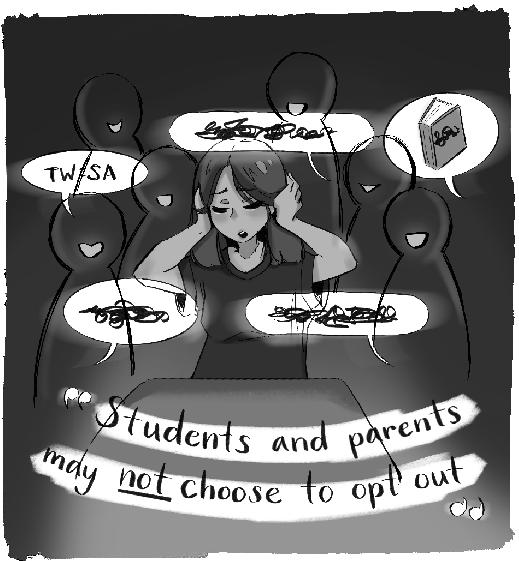
The Silver Chips Editorial
board has an issue with the policy’s one-size-fits-all approach in addition to the way MCPS rolled it out—before the announcement of the policy, there were no opportunities for community discussions and no occasions for the county to receive feedback of any kind.
By skipping this crucial step, the county limited the options for concerned MCPS families that wanted their voices heard. Many protestors advocating in favor of an opt out policy expressed their position on behalf of their religious communities, advocating for more consid-
eration for children coming from devout households. While such claims surrounding the texts may be rooted in bias or fear, the lack of communication or opportunity for dialogue from MCPS has only exacerbated the negative response.
Following the policy’s announcement, community members resorted to protesting, or, in the case of six parents, suing the county for infringement upon their first and fourteenth amendment rights.
The opt-out policy raises concerns that are not just limited to the new LGBTQ related instructional materials; it applies to and thus concerns all teaching materials, including thousands of classes, tens of thousands of books, and innumerable lessons.
These materials service the county’s 160,000 students and over 24,000 employees in their 210 schools. It is the 17th largest school district in the United States. The new ban on opting out falls short of representing the diverse lived experiences present in Montgomery County. The previous policy allowed for a more personal approach; the staff member who decided if a student could opt out understood the student, their situation, and the specific material being taught. Be it a teacher, counselor, or principal making the decision, the old policy allowed for discretion and flexibility when the situation required it. This new policy instead chooses to apply a blanket rule to hundreds of thousands of students, taking an ineffective, onesize-fits-all approach in an attempt to handle a sensitive and politically explosive issue.
When CNN made the decision to host a May 10 town hall with Donald Trump, they knew the deal they were striking. They would air election denials, lies so numerous and vociferous that the moderator could not hope to keep up, and numerous attacks on E. Jean Carroll, the woman a New York jury found Trump was liable for sexually assaulting in the 1990s in a dressing room in the Bergdorf Goodman department store. In exchange for their primetime slot, CNN received 3.3 million views—nearly triple their typical viewership of that same slot.
CNN had no way of knowing that their town hall would take place the day after Trump was found liable for sexual assaulting and defaming E. Jean Carroll, who was awarded damages worth $5 million. Let’s call it a happy accident for their ratings. The network did announce the town hall on May 1, the same day Carroll was cross-examined in the trial. CNN knew that the ongoing trial or verdict was going to be brought up by Trump. If the presiding judge was unable to stop Trump from tweeting attacks at Carroll and her lawyers, a CNN
moderator was never going to stop him.
Said moderator, Kaitlan Collins, was interrupted nine times by applause during the 70 minute segment. She was talked over, frequently interrupted, and directly insulted as a “nasty person,” with the much-hyped live fact-checking becoming basically impossible by the end, as the lies simply became too abundant for Collins to hope to address them all. To be sure, she was trying her best. It is simply a Herculean task to fight off 300 audience members hand-picked for their extremist views while the candidate in question threatens to stomp on the network’s logo and tells over 24 lies by The Washington Post’s count. There was not too much more Collins could have done without her
The Atlantic, he revealed that he had told underlings that he wanted the town hall to be “extra-Trumpy.” This, as well as other revelations inside the 15,000 word article, prompted Licht’s dismissal on June 7. One of the major points inside the profile was that CNN had specifically sought out MAGA extremists to be in the audience, rather than an average GOP audience as they had promised. The crowd was undoubtedly, loudly, proudly supporting the former president: commercial breaks were punctuated with shouts of “I love you!” from supporters; chants of “Four more years!” could be heard when Trump left the stage; and cheers broke out among the crowd at the mention of the Jan. 6 insurrection, while laughter and applause followed Trump’s attacks on Carroll and Collins.
Despite Licht’s assertions that the town hall was merely showing the American people who Trump was, CNN was actively meddling in the live coverage. When the graphics under Trump mentioned the words sexual assault, one of CNN’s executives ordered it taken down.
PHOTO BY MARGOT BUEHLERTo contact Talia email her at
scombud@gmail.comnetwork supporting her.
The whole spectacle was the brainchild of CNN’s new CEO, Chris Licht. In a June 2 profile in
CNN has consistently struggled with their ratings with Trump no longer in office. While this town hall could be spun as an attempt to kick off the presidential election season and the ensuing
ratings bump associated with the high-stakes event, the recent ratings cannot be spun in any positive light for the network. In the week after the town hall, CNN had their worst ratings since June 2015. Their viewership fell to half of MSNBC’s, and a third of FOX’s–at a time when FOX’s views are down 41% percent after Tucker Carlson’s departure. The endless quest for the ratings, the clicks, and the hits brought CNN to the table with one of their biggest critics, and they got deservedly burned, losing profits, their CEO, and their reputation as a reliable network.
If the presiding judge was unable to stop Trump from tweeting attacks at Carroll and her lawyers, a CNN moderator was never going to stop him.Editorial Cartoon SOPHIA LI
The blanket rule may have unintended consequences
Picture this: a student moves from one state to another, and despite the change in scenery, they seamlessly continue their education without missing a beat. That is the magic of the Common Core curriculum. The Common Core curriculum has been beneficial to student education since its imposition in 2010; it set higher standards for educators to reach, geared learning toward critical thinking rather than memorization, and most importantly, prepared students for college and the workforce by equipping them with necessary skills.
The Common Core curriculum established a consistent set of learning goals and standards across states, ensuring that students received a comparable education in the English Language Arts and in mathematics regardless of their geographical location. This standardization promoted a coherent educational experience and allowed for smoother transitions for students moving between schools. This was a reality for Josh Brown, a graduated Blair student who moved from Pennsylvania prior to his Senior year.
Brown had a history of transitioning between schools, including shifts from Virginia to Pennsylvania to Maryland, but still found a notable consistency in the math curricula across the states. “I was able to pick up where I left off, definitely in math,” Brown said. But, Brown added that there were overlaps and holes for subjects such as science. “Some schools would do something in sixth grade that another school did in seventh grade [which] was either repeated or skipped,” he said. Unsurprisingly, the discrepancies in the transitions for Brown were in the subjects where the nationwide Common Core standards did not apply.

Another primary advantage of the Common Core curriculum was its emphasis on critical thinking and problem-solving skills. The curriculum encouraged students to analyze information, evaluate evidence, and develop their own conclusions. For example, the National Council of Teachers of Mathematics (NCTM) states that the Common Core math curriculum employs five process standards, including problem-solving, reasoning and proof, communication, connections, and representation. This approach equipped students with the ability to apply mathematical concepts to various situations, enhancing their abilities to think critically.
Jazmine Delos Reyes, Blair’s college and career information coordinator, echoes the real-world applications that the standards prepare students for post-secondary education. “There are aspects of [the common



core standards such] that it really does prepare you [for life after high school],” Delos Reyes said. “I do believe that [Common Core standards] reconfigure a student’s mind to think critically and persevere through hard questions and hard tasks.”


Additionally, the Common Core English Language Arts standards emphasize close reading, evidence-based writing, and the ability to make arguments based on textual evidence. This focus on analysis and argumentation helps to develop students’ reasoning skills and prepares them for higher education and careers.

Understandably, critics have argued that the nationwide Common Core curriculum has limited teacher autonomy and creativity. However, the curriculum allows for flexibility in instructional meth ods, while ensuring essen tial learning outcomes are met, as seen in an assessment of the Common Core standards by the American Federation of Teachers (AFT). The assessment highlighted that the standards provided a framework that allowed teachers to develop les sons and select resources aligned with their students’ needs and interests.
Nevertheless, there is potential for improvement with in the content of the curriculum. Delos Reyes concedes that the Common Core standards contain faults that can be improved upon by broadening the scope to include national financial literacy standards, among other necessary post-secondary education skills. “I would love [for financial literacy] to be added to be part of the Common Core… I think an actual class that will prepare [students] for adulthood would be just the cherry on top,” Delos Reyes said. Yet again, despite potential improvements, the common core state standards have ultimately unified the nation in providing K-12 students with seamless transitions between school systems and timeless critical thinking abilities.
Since the implementation of the Common Core curriculum, it has failed to produce higher-achieving students and acknowledge the individuality and variety of each student’s needs. The curriculum was first implemented in 2010, when 40 states signed onto the Common Core State Initiative plan. It attempted to improve low test scores across the country by raising academic standards and expectations of achievements across the U.S.
The original idea behind Common Core State Standards (CCSS) was well-intentioned because the uniform curriculum addressed the problem of unequal education. Furthermore, Common Core allowed for more ways to measure education across the country. However, higher expectations do not necessarily lead to higher results. We cannot expect to raise academic standards without providing the resources needed to achieve them.
After Common Core was implemented, there was barely change in students’ state test performances, showing the curriculum did not positively impact students.
Jeremy Abarno, former special education teacher and current Educational Consultant, explained the significant change in student performance. “It wasn’t delivered with better instructional practices, teacher training, intervention programs, or special education support and differentiation,” he said. The current curriculum also does not include necessary diverse perspectives and experiences. According to the Washington Post, “Of 171 texts recommended [CCSS] for elementary children… There are only 18 [texts] by authors of color, and few books reflect the lives of children of color and the
poor.” If all students were expected to learn the same material and reach the same academic level, that material should be equally representative of all. Unfortunately, it was not, and remains as such. Many students continue to learn about their own culture, history, and stories, while others can’t relate to the material so easily.
While holding all students to the same expectations has its benefits, it must be considered that not all students learn under the same circumstances or receive the same resources. Students need varying amounts of support, so while these expectations are equal, the route to achieving them is not. In fact, a Harvard Study conducted in 2021 concluded that the Common Core is widening the achievement gap between high and low income students because it has detrimental effects on the most vulnerable populations.
According to the study, “The CCSS decreased student achievement in non-targeted subjects, particularly for underprivileged students… [and] increased racial/ethnic and socioeconomic student achievement gaps in non-targeted subjects, with potentially long-lasting consequences.”
Abarno explains how lack of teacher preparation worsens the achievement gap.
“If there aren’t requirements or training programs in place for teachers to deeply understand the content… less trained teachers are going to work in schools or historically underserved communities. [The] children are not getting teachers who understand the rigor [or] the demands of the common core, meaning that they’re far less likely to actually get the kids to achieve.”
Essentially, though the intentions behind Common Core are reasonable, the way it was implemented in American schools has left many students with unequal opportunities to achieve. “You cannot have high expectations without high support,” Abarno says. “You need both.”
“I don’t like [standardized learning] too much because I think everyone has their own different way of learning and its helpful for learning to be changed for specific people.”JOSEPH
ALITOjunior
All photos by Madeline Gold
“I think [the common core] affected [education] well since standardized testing helps out a lot of students.”TOMA FRITZ freshman
“[The common core] does impact people some people because sometimes people just don’t want to do the test.”
“I think it is important to all have the basic understandings but at the same time if people need to be challenged, to challenge them”ABBY GREENBERG sophomore
The curriculum sets higher standards for educators, gears learning toward critical thinking, and enables government bodies to uniformly track student performance.
The Common Core curriculum has failed to address each students’ personal needs and has proven to be uneffective thus far.PHOTO BY RAFFI CHARKOUDIAN-ROGERS PHOTO COURTESY OF HENRY REICHLE MINA RICOTTI By Lynne Harris Guest Contributor AN OPINION

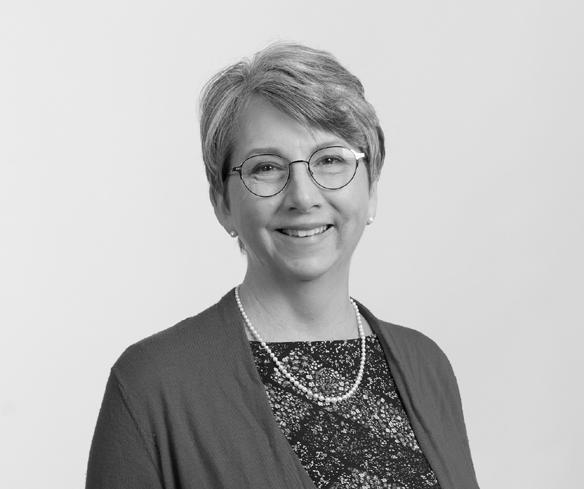
The process of finalizing the Montgomery County Public Schools’ (“MCPS”) FY24 Operating budget is coming to closure as the Fiscal Year rapidly winds down.
As someone who has watched, analyzed, and participated in that process for over a decade in various roles, this year has been one of many firsts, unique challenges, cautionary tales, and in the end – I believe – important opportunities. Strong public schools are an enormous public benefit to everyone.
The crafting, modification and passage of MCPS budgets is a collaboration between MCPS and the Board of Education (“BOE”) on
one hand, and the County Council on the other.
The process is essentially the same whoever sits in the seats and makes the decisions, but this has been a tough year, a bit of a bumpy ride, and a historic one in many ways. For MCPS – the budget is historic in size -$3.165 billion, the County share of that $1.995 Billion. The budget is also historic in need – as we continue to recover from the pandemic’s wide-ranging impacts on learning, social/emotional development and mental and physical wellness.
It has also been a historic year for the County Council -- expansion from a 9- to 11-member body, for the first time majority women, and for the first time in a long time, the majority of Councilmembers (six of eleven) are new – elected last November and sworn in on December 6. As someone elected to the BOE in 2020, and sworn in on December 1 that year, I know first hand what it’s like to begin elected service as the annual budget cycle is in full swing. It’s a disorienting sausage grinder as information in complex detail comes flying at you.
The BOE also had a significant number of members (three of eight) new to the intense budget process. In hindsight, realizing the number of decisionmakers newly in their seats as budget season pro-
graphs of background that’ll make you more informed than most voters about how the county’s budget works. (Side note: We should lower the voting age.)
The county’s budget is divided into two parts:
 By Kristin Mink Guest Contributor AN OPINION
By Kristin Mink Guest Contributor AN OPINION
I’m a Blair graduate (Blazers ’03!) and Silver Chips alum, a former MCPS teacher, and a County Councilmember as of last December. And I just voted against the County’s operating budget in large part because it underfunds MCPS. I’m writing this because you deserve to know how the shortage might impact you.
First, bear with me for two para-
• Capital Budget: the plan for how much we’ll spend on construction and renovation of public schools, as well as roads, buildings, park trails, and any other projects
• Operating Budget: the plan for how much we’ll spend on basically everything else, like paying County employees (librarians, bus drivers, police, etc.), funding shelters and food banks and healthcare programs, maintaining our buses, and keeping the lights on in County buildings. The biggest part of our operating budget goes to our largest and most important program: MCPS.
presented by the superintendent and board of education. Councilmembers were unanimous in stating, even though they would not fully fund the school system, that they expect MCPS will fully honor the agreements that it has made with the three unions that represent teachers, administrators, and support professionals.
By Jennifer Martin Guest Contributor ANWhen it comes to funding our schools, this was the county council’s year of magical thinking. On May 25th, the council voted to approve the Fiscal 2024 budget that includes funding for only two thirds of the request for new spending
gressed, we could have expected that the “normal” ways of doing things might be questioned, and new decision makers would want more granular detail to understand the large and complex budget of the nation’s 13th largest school system.
On top of that reality, the County Executive supported the MCPS budget request, but announced that current county revenue projections were inadequate to meet the FY24 budget requests. Because the County Charter provides limited means for the County to generate revenue, the County Executive proposed a 10% property tax increase, from .98/$100 valuation to $1.08/$100, in order to fully fund the MCPS budget request.
For context, Montgomery County’s tax rate is solidly middle of the pack in comparison to other jurisdictions in the DMV. However, increasing taxes is never a popular proposition, and for a variety of reasons most Councilmembers were unwilling to entertain the 10%/10 cent increase proposed.
The Council deliberated and debated, MCPS provided additional information to answer budget questions, in the end the Council passed a 4.7% tax increase, and the County reduced its portion of the MCPS budget request by about $74 million. In numerous public
Every spring, the County Council looks at how much money we have from taxes and other revenue sources like the County-run ice skating rinks, and we decide how we’re going to divvy it up over the next year. If we have more revenue than we need, or not enough, we may lower or raise taxes.
The Problem
This year, a majority of the Council voted to give MCPS almost $80 million less than requested. MCPS will need to make cuts, and roll back plans for improvements. This is at a moment when we have record numbers of students living in poverty, receiving special education services, and learning English as an additional language. Academic and mental health needs are high. Teachers, counselors, and support staff are leaving (because they’re overworked and under-paid). And we’re growing by around 2000 students per year. Here are a few areas there will be cuts:
• Tutoring
• Staff training
how those will affect instruction and programs. We do know that given the size of the cuts, there will certainly be a felt impact. But the county and MCPS appear to agree that the top priority needs to be restoring respect for the education profession—and a key to demonstrating that respect is through improved compensation.
work sessions the BOE discussed what to cut from its initial budget request, with trepidation moved important pieces of the base budget to ESSER, and publicly shared the results to provide clarity about what to expect in the coming school year.
Everyone predicts that next year’s budget process (which literally will begin in just a few weeks) and revenue pressures will also be difficult. Particularly for MCPS, given the number of important pieces of the base budget (including social workers, school psychologists and Parent Community Coordinators) covered with ESSER funding for FY24, we must be very mindful of finding ways to move those to the base budget when ESSER funding evaporates next year.
But what we’ve learned during this bumpy budget cycle I believe will make the FY25 process better, more collaborative, more openly transparent. Having so many new decisionmakers is an opportunity to reframe the way the Council and MCPS/BOE collaborate throughout the year around the work of the school system and how our budget is meeting the needs of our students. Both the County and MCPS benefit from extraordinarily smart and capable budget and finance staff. Providing budget information in formats, and with the detail
• Out of School Time
Here are a few things MCPS planned to add but now will not:
• Enabling counselors to spend more time counseling students (by hiring staff to help with their excessive administrative work)
• Speeding up heating and air conditioning repairs and other building maintenance needs (by hiring more maintenance staff)
• Expanding language immersion programs
• Adding College Tracks program to more schools to help more low-income students succeed in higher education And here are some things that MCPS can afford for one year only (because they’re covering the cost with the last of some grant money from the federal government):
• Psychologists
• Social workers
• Restorative Justice program
Student voices should matter the most in the MCPS budget con-
start of the contract year rather than be delayed.
requested by Councilmembers, is something that can be done. Though some of the issues have been framed as a lack of transparency about the MCPS budget, my experience is more that there’s not a lack of transparency – MCPS typically shares information about its budget in great, possibly overwhelming, detail. It’s more an issue of presentation – providing various stakeholders the information they need with the level of detail they want in a truly accessible format –which is not the same for everyone.
Moving forward, MCPS will also generate its budget information in both the 14 Category structure required by the State, and also in a Program-based format – which many have asked for, and will make digesting the budget information easier for many. As someone who sees opportunity everywhere, I look forward to working alongside my BOE and Council colleagues in new ways in the coming year, with a process that honors the need of taxpayers for clarity, and our responsibility to serve the unique needs of every student.
This guest contribution was edited for clarity by Silver Chips editorial staff.
versation. You’re who’s impacted the most, and you’re also our eyes on the ground. Hearing from you throughout the year about what’s working and what’s not, needs that aren’t being addressed, programs that should be expanded or cut, or services that should be improved – that’s useful information, and powerful advocacy for a functional budget next year.
I’m one of three members of the County Council’s Education and Culture Committee. I want to use our regular (public, live-streamed) meetings to ensure the Council passes a responsible MCPS budget next year. Rather than waiting for next Spring to start the discussion, we’ll work with the Board of Education throughout the year to analyze how the tight budget is playing out. Student input will help us amplify, learn more about, and respond to your concerns.
Please email my office with thoughts or questions about this or any issue any time: Councilmember.Mink@montgomerycountymd. gov.
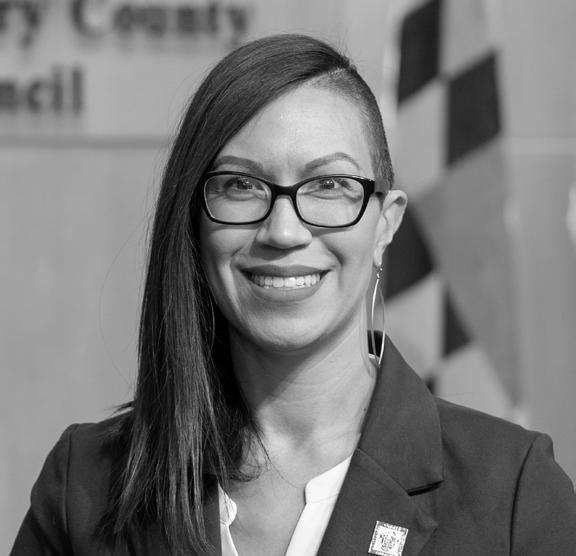
How can this feat be accomplished? The council has forced MCPS to make serious cuts to programs and services and use onetime funding sources like the federal emergency covid relief money. Those federal funds were received to address the effects of the pandemic to fund ongoing operations, and they will not be available after next year.
What will all this mean for students? It remains to be seen exactly what cuts will be made for the 2023-2024 school year and
If we are to have excellent educators in every classroom next year, it is imperative that we bring the pay in line with the wages for similar professions. The new contractual agreement between MCEA and MCPS is designed to address the ongoing staffing shortages by increasing compensation with a $5,602 cost-of-living increase and step progressions. (In the salary scale, steps are increments based on an employee’s years of service.) And for the first time in years, these wage adjustments will occur at the
There are other improvements in the contract that address educators’ working conditions. When teachers lack adequate planning and preparation time, students can’t get the support they deserve. The agreement creates a pilot in a number of elementary schools to provide increased planning time, the level where teachers have the least time without students. We also gained increases in stipends for coaches and sponsors. This should help ensure that students have access to activities and clubs that enrich their school experiences.
The council, to be fair, did not solely rely on cuts to create next year’s operating budget; they also instituted a tax increase of 4.7 cents on every $100 of assessed value for real estate. However, the county executive had earlier proposed a
ten-cent tax increase, wishing to fully fund the schools and recognizing it is unwise to use one-time money to fund ongoing costs. When the council begins to plan for the 2024-2025 fiscal year, unless there is tremendous economic growth (which no one anticipates), they will be faced with the unpleasant prospect of raising taxes again, or the gruesome task of making more cuts to our schools and other county services.
We were pleased to join with students this past budget season in the call for full funding for our public schools. Students know even better than educators what is needed to ensure everyone has access to excellent learning opportunities. We are stronger together!
When Asian American and Pacific Islander (AAPI) Month and Jewish Heritage month, both celebrated in May, were in full swing, Blair administrators and students held a variety of events to celebrate the vibrant cultures. However, many students did not take the initiative to plan or attend activities to deepen their understanding of Asian American history, traditions, and contributions during this month.
In light of the recent rise in anti-Asian hate crimes, as well the spike in antisemitism all over the United States, it is especially imperative for students to take time in May to engage with the cultures of these vulnerable populations in order to counter the rise in ignorance and gain a thorough understanding of how their actions could harm Asian American and Jewish students at Blair.
Blair Diversity and Inclusion
Coordinator Dr. Celita Lewis-Davis explained that celebrating each others’ cultures is crucial to fostering unity within Blair’s diverse community. “As we share cultural differences, we find more similarities… I think that being able to show our differences allows [us] to be seen more and for [students] to be able to express who [they] are. [We] can’t do that unless we are able to showcase everyone,” Lewis-Davis said.
Yet, AAPI and Jewish Heritage
months are not nearly as recognized and celebrated as other cultures at Blair. “We usually only bring up Hispanic Heritage and Black History Month and I wanted to include [Jewish Heritage month],” Lewis-Davis said. Lewis-Davis attributes the lack of engagement in arranging Jewish Heritage month events to its recent establishment as a celebration, “[Jewish Heritage month] was started in 2019, so it was something that people were not particularly aware of… Maybe that’s why I didn’t get deep participation [when I tried to set up events],” she said.
Blair students have also noted that Asian American and Jewish celebrations are often overlooked. Blair junior Solomon Gold noted that there is a lack of awareness of Jewish Heritage month. “When it was Hispanic Heritage Month or Black History Month, everybody knew. It’s pride now, everybody knows that. So Jewish Heritage month should be advertised more,” she said.
Furthermore, it is important to consider that the majority of AAPI month activities were student-organized, and Blair administrators relied on students and clubs to plan activities. The lack of Jewish Heritage month activities was a direct result of the lack of student initiative in planning and organizing events.

“I always go through the club for activities and I asked Jewish teachers, can we have an activity? They [said] no… We didn’t have another person to take that on. If [clubs] don’t do something, then it would be me doing everything, [but] I can’t represent a community I’m
not a part of because then it looks disingenuous,” Lewis-Davis says. “I wish I would have had some activities but all the plans fell through.”
While amplifying student voices is very im- portant, Blair staff and ad- ministrators should not rely entirely on students to organize events for heritage month celebrations. When students don’t take the initiative to facilitate events, Blair staff, especially Asian American and Jewish staff members, should take over to lead celebrations instead.
hosted by Blair’s South and Southeast Asian Alliance Club and the K-pop dance club, on May 18. The AAPI showcase featured eight Blair groups and individuals performing acts such as poetry, songs, and dances that represent Asian American culture.
Still, for AAPI month, there were countless opportunities for Blair students to celebrate and educate themselves about Asian American culture that were not always taken advantage of to the fullest extent. One such AAPI month event was
Blair senior Sophia Dominguez, one of the organizers of the event, hopes that there is more engagement with the showcase next year. “There’s no ‘too much’ when it comes to an audience, especially since the main reason we first started this showcase was because we felt like there wasn’t that much AAPI representation and celebration. It’d be great if next year we could have even more people support it,” she said.
The lack of participation reflects a disinterest in learning about Asian American cultures among Blair students. Even when students took the initiative to organize AAPI events, their peers showed disengagement. “Maybe they don’t hear about it or they’re busy with other things and they just don’t prioritize it. But I think [the showcase] should be the highest priority for people to come see,” Blair junior Akiva Rosenzweig speculated. Given that Asian Americans make up nearly 13% of Blair’s population, it is all the more critical for students and administrators to actively engage in understanding and appreciation of the heritage of their Asian American peers.

Blair sophomore Juliet Allen speculated that the fact that May was both AAPI month and Jewish American Heritage month may have caused confusion and contributed to the lack of attendance at many activities. “It is also Jewish American history month and the fact that those two get lumped together kind of muddles everything up and gets everyone a little confused, so that might be a factor in it also.” In addition, May was filled with exams for many students, which may have contributed to the lack of attendance. “There’s just a lot going on this month,” Allen concluded.
Even so, Blair administration was sure to keep the hectic schedule in mind when planning events for the month. “We intentionally chose the karate demonstration to be after the Japanese AP exam. We tried to do it near the end of AP exams since we didn’t want to interfere with [them]… We knew it was a testing month. We also knew that seniors were leaving on the twenty-third, so I didn’t plan anything after the twenty-third be-
cause I didn’t want seniors to miss that experience,” Lewis-Davis explained. Given the careful planning of events around the exams, Blair students should stop using “testing month” as an excuse and take advantage of the opportunities curated for them. Although Blair administration did their best to plan around the busy month, several students were unhappy with the way in which they handled it, specifically the fact that the innovation slides recognizing the two months were lumped together and squeezed into one period.
“[The Jewish Heritage month innovation] was packed after an Asian American Heritage Month one, so people were running out of time and not really doing the Jewish Heritage [part]. You could have missed a day and not [realized] it was Jewish Heritage [month]… I feel like it’s kind of disrespectful to both groups,” Gold said. By combining the subjects, it gave the impression that Blair administrators merely viewed them as topics to get through, rather than genuinely celebrating the individual cultures. “I think that both topics separately deserved more attention than they got… It just made them both seem like, ‘these are things we had to get through, here’s just a bunch of things thrown into one innovation,’” Blair junior Nathan Gehl added.
Gold added that it’s very important to discuss Jewish culture due to the significant impact Jewish people have had on America. “Jews have had a pretty profound impact on American culture. Many of the biggest Studios in Hollywood, like Warner Brothers, were created by Jews. American comedy has a very strong Jewish tint,” she explained.
Lewis-Davis hopes that Jewish Heritage month activities ramp up in the coming years, given this was the first year that Blair truly celebrated both AAPI and Jewish Heritage month. “The first year always comes off a little weak [but] because there is passion, I’m hoping that clubs and individuals will take interest and help plan for future events. It would be my dream,” Lewis-Davis expressed.
Ultimately, Blair administration’s inaction in organizing events centered around these cultures stems from a lack of student-driven initiatives, and even when students do step forward to facilitate such events, their peers still do not participate and engage. To counter this, Blair staff members should step up and take over if students are unable to organize events rather than forgoing all celebrations altogether. Still, Blair students need to take a more active role in both planning and attending AAPI and Jewish Heritage celebrations in order to better promote inclusivity and recognition of all cultures.
En años recientes, la inmigración ha seguido siendo un tema polémico en los Estados Unidos, alimentando acalorados debates e inspirando cambios significativos en las políticas. Desde la introducción de nuevas leyes en Florida hasta la implementación del Título 42 y legislación posterior, el panorama de inmigración del país está experimentando profundas transformaciones.
América Latina se convirtió en la principal región de origen de los inmigrantes estadounidenses en 1990. En 2019, los migrantes de América Latina representaban el 6,5 por ciento de la población de los Estados Unidos y los inmigrantes hispanos constituyeron el 44 por ciento de los 44.7 millones de inmigrantes de la nación. Solo México representa una cuarta parte de la población inmigrante en los Estados Unidos, o 11.4 millones de personas, significativamente más que cualquier otro país. Además, durante la última década, un número creciente de inmigrantes han llegado de Venezuela, Guatemala, Honduras, El Salvador y la República Dominicana. Recientemente, numerosos inmigrantes centroamericanos y otros han llegado en busca de asilo, con cruces fronterizos que alcanzaron máximos de media década en el últi-
mo año. A pesar de tener niveles relativamente bajos de educación, los inmigrantes indocumentados hispanos tienen altas tasas de participación en la fuerza laboral y empleo, especialmente en ocupaciones esenciales.

Florida, conocida por su población diversa y vibrantes comunidades de inmigrantes, ha sido testigo de una ola de legislación de inmigración que ha provocado tanto apoyo como críticas. El 10 de mayo de 2023, el gobernador Ron DeSantis aprobó el Proyecto de Ley del Senado (SB) 1718. Comenzando el 1 de julio, proporcionar transporte a personas indocumentadas de fuera de Florida al estado es ahora un delito penal castigado con hasta 15 años de prisión. Además, las empresas con más de 25 empleados están obligadas a usar E-Verify, un sistema de-
fectuoso que determina la elegibilidad laboral en función del estatus migratorio, y se requerirá que los hospitales soliciten el estatus migratorio de sus pacientes, sólo para nombrar algunos de los cambios que esta ley promulgará.
A pesar de que esta ley aún no ha entrado en vigor, su impacto ya se está sintiendo a lo largo y más allá de las fronteras de Florida, particularmente cuando se trata de los requisitos de E-Verify. El cambio
tima que sin trabajadores indocumentados, los empleadores en las industrias más intensivas en mano de obra perderían el 10 por ciento de su fuerza laboral y, “Como resultado, el PIB de Florida podría caer en $ 12.6 mil millones en un solo año”. Ya, cientos de conductores de camiones latinos han boicoteado, evitando conducir a Florida y ha habido oleadas de videos en las redes sociales que muestran sitios de construcción y campos de frutas y verduras vacíos.
casi con certeza tendrá un gran impacto en las industrias de la agricultura, la construcción y la hospitalidad de Florida. El Instituto de Políticas de Florida, un grupo de investigación de políticas sin fines de lucro, es-
Además de las nuevas leyes en Florida, el uso del Título 42, una medida de salud pública adoptada en respuesta a la epidemia de COVID-19, es otro desarrollo notable en la política de inmigración contem -
poránea. Bajo el Título 42, el gobierno de los Estados Unidos ha utilizado una justificación de salud pública para expulsar a los solicitantes de asilo y migrantes sin
darles la oportunidad de buscar refugio o solicitar ayuda humanitaria. Desde la expiración del Título 42 el 11 de mayo, el número de personas bajo custodia se disparó y la administración Biden ha implementado nuevas políticas para tratar de limitar la cantidad de personas que cruzan la frontera ilegalmente. Ahora habrá consecuencias estrictas y a los migrantes atrapados cruzando ilegalmente no se les permitirá regresar durante cinco años y pueden enfrentar un proceso penal si lo hacen. Bajo la ley estadounidense e internacional, cualquier persona que venga a los Estados Unidos puede pedir asilo, pero la administración Biden ahora está rechazando a cualquier persona que busque asilo que no haya buscado primero protección en un país por donde viajó, o que primero solicitó en línea. Estados Unidos ha dicho que aceptará hasta 30.000 personas por mes de Venezuela, Haití, Nicaragua y Cuba, siempre y cuando vengan por aire, tengan un patrocinador y soliciten primero en línea. El gobierno también permitirá que hasta 100.000 personas de Guatemala, El Salvador y Honduras que tienen familiares aquí ingresen a los Estados Unidos si también solicitan en línea.
Con todos los recientes cambios legislativos, las comunidades latinoamericanas e inmigrantes continúan enfrentando adversidades en ambos lados de la frontera.
venirla prácticamente en general. El evento pasa cada año para educar y reunir a la comunidad”.
El mes del orgullo para la comunidad LGBTQ sirve como una oportunidad para la educación y conciencia sobre asuntos importantes qué afectan a la gente queer. Esta celebración puede tener variedades de expresiones, en la forma de desfiles, fiestas, o en el caso de la organización Empodérate, una coronación.

Empodérate es una organización en asociación con La Clínica del Pueblo, una clínica localizada en DC, qué trata de aumentar la educación alrededor de la salud sexual, y ofrecen recursos para la salud en general. El dos de junio, un viernes, Empodérate organizó una coronación qué ocurre anualmente dedicada a la comunidad queer hispanohablante, y localizada en el edificio de La Clínica.
Globos de todos colores formaron un arcoiris en la entrada de la clínica, y la música invitó a la gente asistiendo al evento a bailar. La socialización entre todos los tipos de personas resultó en un espacio vibrante con diversidad de experiencias y expresión. Antes de empezar la celebración, Empodérate empezó con una presentación sobre enfermedades de transmisión sexual.
Un miembro de la comunidad de Empodérate, Jonathan , comenta en la presentación que pasa anualmente cómo parte de la coronación, “Tuvimos una presentación acerca de la enfermedad de transmisión sexual, cómo pre-
Adicionalmente, se ofrecieron recursos de anticoncepción o de prevención de enfermedades de transmisión sexual. La coronación cada año resulta en un “Mr. Empodérate”, “Ms. Trans”, y la Reina de Drag, con coronas para cada ganador. Los ganadores se convierten en representantes para la organización después de ganar. La ganadora de “Ms. Trans” de 2023, Diana Portillo, habla un poco sobre la importancia del evento para ella. “Yo tenía 10, 13 años y quería ser la elegida de la corona,” ella comenta sobre Empodérate, “yo he tenido mucho tiempo con la organización que me motivó a ser parte de la comunidad”. No había solamente la coronación y la presentación educativa, sino también unas actuaciones energéticas de “drag” y bailes. Una reina de Drag, Silvana, que ganó en los primeros años del evento, sorprende a la audiencia con su valiente actuación de drag, acompañada con un poema emocional y vulnerable, sobre la experiencia queer. Sil -

vana habla un poco sobre su experiencia en el mundo de drag, y su experiencia con Empodérate y sus eventos de orgullo.
Empezó su carrera en el año 2012, cuando ella tuvo un episodio de depresión cuando la diagnosticaron con VIH. “Hubo un día que mi amiga, que también era un Drag Queen, me dijo que salgamos al club y que podíamos vestir,” ella explica, “y cuando me vi al espejo, indiqué que era totalmente una persona diferente a un cuerpo diferente modificado. Me sentí lleno de vida sin depresión. Tomo drag como una terapia para cualquier cosa que esté pasando en mi vida personal”.
Para Silvana, representar a la comunidad hispana a través del drag es un honor; “Para mi, representar a la gente latina, a personas de color, es un orgullo. Tienes que hacer el ejemplo y darle ver a la comunidad en general que te está viendo, que somos unas personas íntegras que somos respetuosos, y que incluimos a todo mundo a pesar de todo.”
Los eventos celebrados por toda la comunidad
Cuando un nombre aparece sin apellido se ha cambiado la identidad para proteger la fuente.
Nubes de mango, frambuesa azul y de fresa; todos estos olores se pueden encontrar en un lugar inesperado y un poco irónico: en los baños de Montgomery Blair High School. El vapeo se ha convertido en una epidemia para los jóvenes de los Estados Unidos; esto también incluye a Blair. Los vapeadores tienen la habilidad de relajar a alguien pero a pesar de este aspecto positivo, los vapeadores también traen serios problemas de salud.
Desde el año 2014, los vapeadores han sido los productos más comunes de tabaco usados entre estudiantes de secundaria en los Estados Unidos, de acuerdo con el Centro para el Control y la Prevención de Enfermedades (CDC). El CDC también explica que la nicotina en los vapeadores puede tener efectos secundarios negativos en el cerebro en desarrollo y conducir al uso futuro de drogas. El uso de vapeadores aumentó significativamente entre 2019 y 2020. En 2022, el 14.1 por ciento de los estudiantes de la escuela secundaria dijo que usan vapeadores en el presente. Esto crea razones para preocuparse, ya que se considera

una droga de entrada a sustancias más peligrosas y puede ser peligrosamente adictiva. Un estudiante de Blair quiere permanecer en el anonimato y le hemos otorgado este derecho en este artículo así que se le llamará por el seudónimo de Mike. Mike empezó porque sus amigos lo hacían y ahora es parte de su rutina en situaciones sociales. Él explica que, “Nunca he visto a alguien que diga, ‘¡Ay!, ¡voy a empezar a fumar!’ sin ninguna razón social”. Mike cree que el uso de vapeadores realmente es parte de socializar y que solo lo hace con amigos. Desde afuera, existen preguntas sobre el acceso. Mike cuenta que, “hay tiendas que venden vapeadores a los estudiantes sin identificación y también hay estudiantes con hermano o hermanas mayores que los compran [para ellos]”.
Algunos estudiantes de Blair usan los baños de la escuela para vapear, asumiendo el riesgo de ser castigados. Sin embargo, en tiempos recientes, la escuela ha tomado más medidas para prevenirlo. La seguridad en la escuela se ha vuelto más intensa, intentando controlar el uso de los baños para fumar. La administración ha tomado muchas medidas para pararlo, como quitar las puertas de los baños, pero el consenso es qué nada ha sido efectivo. En otras escuelas, como Northwood HS, se han implementado sensores de humo en los baños. Es una idea interesante, pero no efectiva, “en mi corazón,
los estudiantes lo van a destruir”, Mike explica, “No pueden controlar esta actividad y ya han intentado”.
Otro estudiante, por el seudónimo de Quico, dice que la escuela está haciendo lo correcto tratando de parar a los estudiantes de vapear, en los baños, pero no se deben quitar las puertas, “tiene que ponerlas, por privacidad, porque es un baño y todos lo utilizan”.
Las escuelas se preocupan por el uso durante de las horas de escuela, pero el efecto en la salud viene de uso más frecuente durante todas las horas del día. Mike añade que los chicos llevan más tiempo afuera de la escuela, entonces es imposible realmente ayudarlos o tener un efecto en el ciclo de uso. Aunque es ilegal, es tan accesible que no hay manera de prevenirlo, si alguien quiere fumar, puede hacerlo, de acuerdo con Mike.
Hay culpa en las escuelas, los padres e incluso los estudiantes. Las compañías, como Elf y Swft, también tienen responsabilidad en los efectos sobre los jóvenes. Hay demandas judiciales que dicen que las compañías de vapeadores comercializan directamente a niños, usando colores brillantes, sabores dulces y anuncios en medios sociales donde los usuarios menores de edad frecuentan. A partir del 16 de marzo de 2023, hubo alrededor de 6.000 juicios contra la compañía Juul en los Estados Unidos, combinados en litigios multi-distritales.
Al final, no importa de quién es la culpa, ya que lo más grave es el efecto negativo en la salud. Los vapeadores contienen nicotina que es peligrosa y tiene efectos a largo plazo y puede ser especialmente detrimental a jóvenes. Hay reclamos de convulsiones, accidentes cerebrovasculares hemorrágicos, lesiones pulmonares, etcétera.
Pero esto no quiere decir que la culpa no recaiga en las compañías de vapeadores. Juul Labs, el dueño de Juul, fue llevado a la corte por hacer publicidad de productos de tabaco para niños, y ellos acordaron pagar una suma de $462 millones a seis estados y también a Washington DC, por la práctica de publicidad a los niños.
Aunque algunos estudiantes argumentan que fumar con vapeadores es parte de la socialización y que pueden controlar su uso, es importante reconocer los riesgos asociados con esta actividad. Los vapeadores representan una puerta de entrada a sustancias más peligrosas y pueden volverse adictivos, afectando negativamente la salud de quienes los utilizan. A pesar de los esfuerzos de las escuelas por prevenir el uso de vapeadores, como la eliminación de las puertas de los baños o la instalación de sensores de humo, parece que, por el momento, estas medidas no han sido efectivas.
A principios de mayo, Miami fue el anfitrión para el evento de conducción de autos de carrera en el Fórmula 1 Grand Prix. El Miami Grand Prix es un evento de carreras anual que atrae a conductores y aficionados de todo el mundo. Este año, conductores de veinte países y cinco continentes participaron en la competencia. Hay tres carreras de Grand Prix que ocurren en los Estados Unidos. Generalmente son en Miami, Florida, Las Vegas, Nevada y Austin, Texas. Pero para el Grand Prix de Miami, el evento principal de la carrera, ocurrió en el Autódromo Internacional de Miami, aunque las festividades del evento no estaban limitadas a la pista de carreras.

El Miami Grand Prix es un evento de carreras anual que atrae a conductores y aficionados de todo el mundo.
Los eventos empezaron el 5 de mayo y duraron tres días. Empezó con una ronda de práctica el viernes, siguiendo con una carrera eliminatoria el sábado, y el Grand Prix el domingo. Todas las festividades del Grand Prix empezaron fuerte con un concierto de Wisin & Yandel de música latina urbana. Durante el evento, había muchos pases diferentes para los clubs de playa, junto a la pista, la casa de bo-
tes y mucho más. Un gran aspecto del Grand Prix, aparte de las carreras en sí, son las festividades que lo rodean, incluyendo los conciertos del fin de semana. El concierto principal del evento es el Concierto Oficial Grand Prix donde los Hermanos Jonas cantaron este año. El evento también es conocido por su comida. Con 65 restaurantes que participaron en el evento, incluyendo 14 restaurantes locales que son propiedad de minorías, definitivamente no falta la comida de buena calidad en el evento. En adición a restaurantes locales, Fórmula 1 trajo chefs bien conocidos, como Michelle Bernstein, una cocinera premiada que trajo su enfoque en comida latinoamericana. Todavía, la mayoría de los cocineros bien conocidos se podrían encontrar en clubs lujosos, en lugar de la sección de admisión general.
Considerando la cantidad de eventos que ocurrieron para celebrar este acontecimiento y las estrellas que participaron en los eventos, no es sorprendente que haya mucha prensa alrededor del suceso, como se muestra entre tik toks hechos por los competidores, comerciales relacionados al evento con conductores
famosos, artículos con las mejores cosas para hacer durante el fin de semana del Grand Prix, y la publicidad del evento en redes sociales. Los ganadores de este Grand Prix fueron Max Verstappen de Holanda en primer lugar, después Sergio Perez de México en segundo lugar, y finalmente Fernando Alonso de España en tercer lugar. Al principio de la carrera, Verstappen empezó atrás en noveno lugar con su compañero de Red Bull, Sergio Perez, en primero, pero pronto se recuperó y mantuvo el primer lugar en la carrera. Para el ganador, Max Verstappen, que estaba compitiendo para Red Bull, esta victoria fue su cuarta
en la temporada. Una gran diferencia entre los aficionados del Grand Prix son los que consiguieron admisión general sólo para poder ver la carrera y los que pudieron conseguir pases VIP para poder ir a los clubs en yates y de playa. La experiencia del Grand Prix variaba tremendamente según lo que las personas pudieran pagar. Entonces, ¿cómo se consiguen boletos para el Miami Grand Prix? Como muchos eventos de conducción de autos de carrera, general- mente
se puede conseguir en el sitio web oficial del evento. El pase de campo empieza a 100 dólares por uno de los días del evento. Los precios suben tremendamente después de eso en relación a los pases VIP. Estos incluyen pases diferentes que vienen separados para los yates de Miamarina y para las suites de club. Para las personas que no pueden conse-
guir esos tipos de pases, el evento todavía es muy divertido en sí mismo. Entre la comida, la música, y la carrera, sería difícil no pasarlo bien.. De hecho, ya están a la venta los boletos para el Miami Grand Prix 2024, entonces va a ver una nueva oportunidad de experimentar todas estas festividades otra vez el próximo año.
BLAIR Un estudiante usando un vapeador en el baño durante escuela. FOTO POR FIONA BONDAREV
En esta escuela hay una variedad de culturas, razas, religiones que se complementan para crear una diversidad única en Blair. Recuerdo mi primer día de escuela, muy nerviosa, levantándome a la seis de la mañana, pues tenía que hacer algo de desayuno, asearme, y salir a esperar el bus, que sin sentir, se convirtió en una rutina, como cualquier otro estudiante. Algo bastante gracioso que me había pasado el primer dia es que una chica de
origen asíatico empezó a hablarme durante la hora de receso mientras hacía fila para recibir mi almuerzo, queriendo que me uniera a una actividad, y me sentía bastante oprimida y asustada, ya que la barrera del lenguaje era muy grande.
Cuando al fin me acostumbré a estas paredes rojas y blancas, solía esperar a algunas de mis compañeras en la cafetería, o caminaba por los pasillos, entraba a la biblioteca en busca de algún libro interesante para pasar el rato y al mismo tiempo, educarme un poco más. Si me alcanzaba el tiempo,
recogía algo de desayunar en el lugar de comida, con personas recibiéndome con una sonrisa y un “Buenos días”, ya fuera en inglés o en español.
Recuerdo mi primera clase, español, de hecho, con la Señora Tanos preguntándome si era nueva o necesitaba ayuda. Mis primeros días fueron una odisea total, pensando a qué lugar tenía que ir, pidiendo ayuda con mi poco inglés. Creo que es algo que todos los latinxs pasan en sus primeras semanas. Sin embargo, como todo hispanohablante sabe, hay que ingeniárselas para cualquier cosa, o si encuentras a alguien del mismo idioma, ayudarlo, como todo mundo podría hacer.
Los choques culturales en este país, con los nuestros, son bastantes. Tal vez has ido a un colegio privado o público, y como sabes, son algo pequeños. En cambio, esta escuela es enorme, con cosas que no sabemos que hay, como los laboratorios, el gimnasio, la cancha de básquetbol dentro y afuera y varias cosas más. Desde un inicio me había sorprendido de que hubiera una cafetería, solo las veía en las películas y pensaba que era menti-
ra. Soy bastante honesta a la hora de dar mi opinión, basándome en varios ángulos o comentarios y sinceramente me sorprendí bastante.
Ahora, la enorme experiencia que me ha gustado mucho, es haber participado en el periodico escolar, con el equipo de La Esquina Latina, que por cierto, les recomiendo bastante si quieren expresarse y a la vez ganar más de alguna hora comunitaria. Ellos estuvieron corrigiendo o dándome detalles, pero siempre apoyándome en cualquier cosa que necesitara o alguna duda que tenía. La verdad es que les agradezco mucho esa oportunidad. Algo que hacía, y admito mi irresponsabilidad, es que si no me acordaba de que tenía un articulo que hacer, o me preguntaban qué


El jueves cuatro de mayo, 22 millas al suroeste de la ciudad de Guatemala, la paz se rompió cuando el volcán de Fuego entró en erupción. Miles de personas tuvieron que evacuar los pueblos más cercanos al volcán y refugiarse en un pabellón deportivo. Esas personas no fueron las únicas afectadas por la actividad del volcán. La ceniza que proviene del cráter cayó a más de 62 millas de distancia en el oeste y suroeste, sin afectar a la capital de Guatemala. Aun así, según la Coordinadora para la Reducción de Desastres (Conred) cerca 280.000 personas estaban expuestas a la ceniza y también los riesgos de salud que la acompaña. Las autoridades ruegan que la gente cubra sus tanques de agua
para prevenir la contaminación del agua por la caída de ceniza. También, por el momento, se pide que la gente traiga mascarillas para evitar que aspiren los gases y ceniza. Si se aspiran estos contaminantes malos se puede sentir irritación en los ojos, ataques de asma y bronquitis, y otros efectos no tan serios. Sin duda, la columna de ceniza que alcanzó más de 19.000 pies de altura puede causar efectos de mayor escala y con impactos internacionales. El año pasado, cuando El Fuego erupcionó en diciembre, el gobierno tuvo que cerrar el Aeropuerto Internacional La Aurora por algunos días. Además, la región, que trabaja mucho en el campo de la agricultura, también puede encontrar nuevos desafíos que dañan los productos agrícolas, tales como la erosión del suelo, corrientes de agua, y una reducción de la fotosíntesis.
Por suerte y también gracias a la previsión y planificación de Conred, nadie murió en mayo cuando el volcán de Fuego escupió lava, cenizas y rocas. Hace 5 años, la historia fue diferente. El estratovolcán Fuego causó la muerte de 461 residentes en las provincias desprevenidas de Escuintla, Chimaltenango y Sacatepéquez, en el centro del territorio guatemalteco.
Mientras que en mayo el volcán no fue tan poderoso, en 2018 los flujos piroclásticos fueron hacia abajo, envolviendo todo en su camino incluso el pueblo de San Miguel Los Lotes.

La erupción volcánica también afectó la industria del turismo. El gobierno cerró la Ruta Nacional 14 que conecta algunos pueblos a Antigua, la atracción turística central de Guatemala y un sitio del patrimonio de la humanidad de la UNESCO. El volcán de Fuego también
atrae entre 100 a 200 turistas cada día y a las seis de la mañana fueron evacuados de la ladera. Después, Conred recomendó que nadie se acerque a 7 kilómetros del volcán hasta que el peligro haya pasado. Este año y también en 2018 ningún turista resultó herido.
Actualmente, la gente de los pueblos que rodean el volcán de Fuego han regresado a sus hogares y la RN 14 se ha reabierto. El volcán de Fuego entra en erupción una vez cada cuatro o cinco años, por lo que es prob -
era lo que me faltaba, porque la fecha de entrega se acercaba, decía que sí, pero no lo había ni comenzado, o quedado a medias. Entonces corría con la excusa de que me faltaba muy poco, y que tal vez durante ese día después de clase o al día siguiente se los iría a entregar, e iba corriendo durante el almuerzo o en mi casa para hacerlo. Mi enorme apoyo emocional fueron los maestros con quienes he podido confiar bastante, ya sea con Ms Brinkman, maestra de baile, con quien compartí bastantes momentos y diversión, o con la Sra Tanos, quien estuvo conmigo mientras afrontaba un problema de familia, escuchándome y dándome consejos. Realmente aprecio el tiempo en el que estuve en esta escuela, pues es donde tengo amistades y sólidas bases de educación. Para finalizar, quiero agradecer a todos por su cálido recibimiento en esta institución, a mis amigos, maestros y demás personas, no hay duda de que la vida da bastantes vueltas, y ¿quién sabe? A lo mejor nos encontramos en un futuro, y volver a convivir otra vez. No suena nada mal…
able que los habitantes estén seguros por los próximos años. Cada día, la tecnología relacionada a la detección y prevención de los desastres naturales y la preparación de Conred y otras organizaciones mejora. Se espera que en algunos años, cuando Fuego regrese con una nueva venganza, el pueblo de Guatemala estará listo. KIMBERLY SOLIS
Realmente aprecio el tiempo en el que estuve en esta escuela, pues es donde tengo amistades y sólidas bases de educación.
Imagínate que estás perdido en Four Corners, con nada más que $3 contigo, dinero que te dio tu mama diciendo que lo uses para una emergencia. Piensas que no hay mejor momento, usas tu cabeza y piensas en las galletas de cada tienda pero, ¿cuál va a ser la mejor opción con el dinero que tienes?
Un estudiante de Montgomery Blair High School tiene unos cuantos lugares para conseguir un pequeño postre cerca de la escuela. Estos sitios incluyen Starbucks, 7-11, McDonald ‘s, Subway, y la panadería Woodmoor Bakery. Cuan do se acaba la escuela, los estudiantes de Blair pueden cruzar la calle para ir a estas tiendas para obtener una galleta. En este artículo averiguaremos cuál es la mejor galleta del área por su precio y sabor con ayuda de estudiantes y profesores con cada categoría las galletas tienen la posibilidad de un máximo de diez puntos, cinco puntos por categoría. Las dos categorías son: precio y sabor. También, debido a las diferentes opciones de las tiendas, voy a evaluar galletas de chispas de chocolate todas las veces.
La primera tienda es Star bucks, con unas de las galletas más caras, costando $2.75 cada una, pero con un buen sabor. Estas galletas están calientes y son
crujientes por fuera pero suaves por dentro cuando el chocolate comienza a derretirse en la boca.
El Sr. Kirk, un profesor de Blair quien en su tiempo ha comido muchas de estas galletas, comenta. “La de Starbucks es como un poco más pegajosa,” y después explicó que así le gustan las galletas. Por esta razón, le doy un seis de
En las palabras de Arianna Bravo, estudiante del undécimo grado, “McDonald ‘s no es conocido por sus galletas”. Se pudo observar que la galleta estaba dura y era un poco pequeña, pero todavía se podía comer. Esto resulta en un seis de diez, con un cuatro en precio y un dos en sabor. La tercera tienda es 7-11.
Cuando alguien piensa en galletas baratas lo que piensan primero es galletas por un dólar. Por eso,
dos, con esto sale saliendo con un precio Pude ver que su ta es que los con eso también
Kirk dice que “hay como 35.000 tiendas de Starbucks. Pero solo hay una pastelería Woodmoor Bakery, así que creo que deberíamos apoyarlo.” Por esto, le voy a dar un seis de diez, un cuarto de sabor y un dos del precio.
La quinta tienda, Subway, ofrece sus galletas por 89 centavos. Elizabeth Duarte, estudiante del décimo grado a quien le gustan las galletas, dice que son “crujientes y por eso necesitan subir el precio”. Por estas razones yo le doy un siete, un cuarto de precio y un tres de sabor.
Si quieres mi opinión de cuál galleta es mejor por precio y sabor, la respuesta es Subway con su habilidad de ser buena en ambas categorías. Pero si el precio no es una preocupación, la de Starbucks es la mejor. Si solo el precio te importa, Mcdonald’s y Subway son las opciones más baratas.
Entonces, si un día te encuentras como un ratón que está pidiendo una galleta, tal vez deberías preguntar también por leche y después una pajilla, pero vas a mirar un espejo para mirar que no tienes un bigote de leche. Recuerda que si solo tienes $3 y estás tratando de encontrar la galleta de mejor sabor al mejor precio, Subway es el lugar para ir. Como dice el sr. Kirk, “apoye a las empresas locales y disfrute de un regalo, disfrute de una galleta”.

El futbolista argentino Lionel Messi, conocido en todo el mundo deportivo, va a unirse al Inter Miami, un equipo de fútbol en la Liga Mayor de Fútbol (MLS). Messi, que ha jugado con FC Barcelona y PSG, además de su equipo nacional de Argentina, anunció el 7 de junio que empezaría una carrera en los Estados Unidos con Inter Miami. Rechazó ofertas de Barcelona, su equipo anterior, y Al Hilal, el equipo más condecorado en Asia, aunque generalmente son más competitivos que Inter Miami. Se espera que Messi comience a jugar en los Estados Unidos en julio o agosto de este año.
Los incendios forestales han dominado el paisaje de Canadá este año, lo peor en toda la historia del país. Según el Centro Interagencial de los Incendios Forestales de Canadá, diez millones de acres, más grande que Maryland y D.C. conjuntos, ya se han quemado. Además, los impactos extendieron fuera de Canadá - El Servicio Meteorológico Nacional de los Estados Unidos emitió alertas de calidad del aire para más de 120 millones de personas en el 8 de junio. Muchas ciudades, como Nueva York, estaban cubiertas por un humo espeso y niebla marrón, así que funcionarios aconsejaron a la gente que se quedara en casa y llevara una mascarilla para estar afuera.
La Copa Mundial Femenina de Fútbol de 2023 tendrá lugar en Australia y Nueva Zelanda del 20 de julio al 20 de agosto. Esto representará la primera Copa en dos países, expandirá el número de equipos de 24 a 32, y triplicará los premios en efectivo para las jugadoras en comparación con la Copa pasada. Habrá cinco países hispanohablantes en el torneo - Argentina, Colombia, Costa Rica, Panamá, y España, además de los Estados Unidos, Brasil, y otros países renombrados en el mundo del fútbol. Los Estados Unidos, con sus victorias en las últimas dos Copas, son los favoritos para ganar, pero Inglaterra, España, y Australia también tienen mucho potencial para robar el trono.
Asummer pool can be a beloved gathering point for a community—a place to cool off in the summer, play with friends, and bond with teammates. With 88 pools and 14,000 youth swimmers in the Montgomery County Swim League, swimming is a popular pastime for many county residents. These pools, however, contain a past full of racism and exclusionism that continues to shape the landscape of its members and the sport today.
Black Americans have faced barriers to swimming since the 1800s, when plantation owners would often punish the act of swimming, seeing the ability to swim as a potential means of escape from slavery. Swimming became popular in the U.S. alongside segregation in the late 19th century. With the end of slavery came housing segregation and disparities; expensive recreational facilities and pools were mainly placed in wealthier, whiter neighborhoods.

“People from other pools [thought] that I was [not] good enough to be a swimmer because [of stereotypes] that Black people can’t swim.”
This trend continued on a wider scale in subsequent decades. When the 1964 Civil Rights Act mandated public spaces be desegregated, rather than integrating, some pools took a different approach—filling in their pools or simply closing down.
struction of new pools in the more affluent Montgomery County suburbs. A number of these pools opened as and remain private swimming clubs, where pool-goers must be members in order to enter. Membership is often contingent on living within a certain
Story by Talia Egnal and Caleb Plank Art by Sophia Li Design by Dyan Nguyenswim.”
The multitude of these factors make it difficult for some private pools around Montgomery County to diver sify their membership, even if they do try. “We don’t weigh it based on wheth er you live in the neighborhood or ethnic backgrounds or socioeconomic means. It is truly a W-A-I-T waitlist. So once you sit in line, then you wait,” Northwest Branch Pool Membership Chairperson Mindy Kassaraba says. Membership at Northwest Branch requires a fee of $651 annually for a family.
Kassaraba adds that to avoid racial bias, information about identity and race is never asked for when applying to the pool. “We don’t take any racial… or religious, or gender and sexuality information when [you] become a member,” she says. “So when you join, you’re just member X.”
ALISA DANIELSAttempts to integrate swimming pools at this time met heavy resistance. White protestors threw nails, bleach, and acid into pools as Black patrons swam. The violence served to enforce segregation within pools, even if it was not enshrined in law. In the late 1940s, riots broke out in Los Angeles, St. Louis, Baltimore, and Washington, D.C. when Black swimmers tried to swim in recently integrated pools and faced violence from white patrons. A riot in Anacostia involved 450 people, seriously injuring four. When the Anacostia pool reopened a year later in 1950, attendance dramatically dropped as white swimmers refused to attend the newly integrated pool.
During this time, Glen Echo Park’s Crystal pool closed its doors. Originally built in 1931, the 500,000-gallon pool could accommodate 3,000 swimmers. In 1960, a group of Howard University students staged a sit-in on the Glen Echo carousel to advocate for the integration of the pool. After the arrest of five protesters, a picket line of students and community members stood outside the gates of the park for the remainder of the season. The protest forced owners to open on an integrated basis in 1961.

As Glen Echo Park Ranger Kevin Patti explains, the decision resulted in reduced profits and the eventual closure of the park in 1968. “The race issue is certainly a part of why the amusement park closed; they didn’t make money for the last five years [of operating].
Is some of that because of white people not wanting to visit the park now that Black people are allowed to go? That’s a very reasonable idea,” Patti says in an interview with Silver Chips.
As more white people moved to the suburbs in the 1950s and 60s, increased funding allowed for the con-
distance of the pool, paying the fees, and, historically, one’s race.

As a result of this history, white Americans are twice as likely to know how to swim than Black Americans. As a consequence, Black children are three times more likely to drown than their white counterparts, and 7.6 times more likely to drown in a public pool. Fear of drowning has often been cited as a factor for why Black parents are reluctant for their children to swim. This fuels a vicious cycle where Black children do not learn to swim and drowning rates increase as a result. Forest Knolls Lifeguard Alisa Daniel believes racism and the exclusionary environments of many pools further discourage Black swimmers. “I definitely feel like being in a predominantly white space can be challenging at times, especially when you’re younger,” Daniel says. “People from other pools [thought] that I was [not] good enough to be a swimmer because [of stereotypes] that Black people can’t

Kassaraba says.
With annual fees ranging from $400 to just under $4,000, these private pool memberships can be a luxury many families cannot afford. Swim team fees, swim lessons, and guest fees can add hundreds of dollars to the sticker price. First-time initiation fees, application fees, and waiting list fees can add thousands. Franklin Knolls Board Membership Chairperson Dave Case explains that their annual $400–$800 fee reflects the high operational costs to stay running. “We are limited in the number of members we can have at any given time, so [we] need each member to contribute in order to keep the pool op- erating and open. If a mem- ber reaches out with dif- ficulty paying dues, we will work with them to be sure that’s not the reason they won’t be able to retain membership,”
Case writes in an email to Silver Chips. Kassaraba corrobo - rates that fees have to bring in a certain amount of revenue since most private pools only
Public pool memberships, however, are significantly cheaper, and were made free for all Montgomery County residents for the year 2023. Construction of a new public aquatic center in Silver Spring has been ongoing since 2019. The 120,000 square foot facility will contain three separate pools, as well as a fitness center, basketball court, game room, hot tub, and teaching kitchen within its four floors. Located around half a mile from the Silver Spring Metro Station, and 2.2 miles from Blair, when it opens in the fall of 2023, it will be the first county recreation center located in Downtown Silver Spring. The manager of communications and public outreach with the Montgomery County Recreation Department, Carmen Berrios, shares how excited the department is to open the center. “It’s the first of its type in the county… It is over 130,000 square feet of programmable space, and we are thrilled to be opening this facility on the aquatic side specifically. There are four indoor aquatic centers that the county operates currently and seven outdoor pools, and so pool space is very hard to come by,” Berrios says.
The new center cost $55 million to build, along with an extra $3 million each year for upkeep. The County Council expects to pay $2 million annually while the center is expected to raise around a million dollars a year, generated from a combination of swim lessons and other program fees. Berrios explains that a new program will give low-income families assistance in affording these fees.
“If you qualify for another county program, like [Free and Reduced
ble individual… to use towards any recreation programming,” Berrios says. “With swimming specifically, our aquatics team does offer some swim lessons free of charge in what we call our equity zones.”
Funding for the aquatic center may seem sizable compared to the funding a smaller pool, like Piney Branch, receives. In 2015, when former County Executive Isiah Leggett proposed cutting funding for Piney Branch, the fees for its upkeep were around $170,000 a year. Although the pool was not drained, the County ended up cutting funding for programs supporting homeless veterans and child care instead, among others. The proposed cuts totaled $54 million for the fiscal year of 2016, the year before the Council approved the $55 million plans for the Silver Spring Aquatic Center. While expensive for the county to maintain, public pools can be a center of the community. Silver Spring is a majority-minority area, with the Black community making up 28.9 percent of the population, over double the national average. Berrios is optimistic that the new center will create opportunities for historically disadvantaged groups to learn to swim. “We are really excited to be able to open an additional aquatic center in the down county to serve that population there,” Berrios says.
Routine traffic stops are associated with varying meanings for different people. For the police, they signify harmful drugs and weapons kept from the wrong hands. For others, they spark fear.
Following a report from the Montgomery County Office of Legislative Oversight (OLO) identifying racial inequities in traffic law enforcement, County Councilmember Will Jawando introduced legislation that would limit the circumstances in which the Montgomery County Police Department (MCPD) can carry out traffic stops.
The report, published in October, analyzes a Traffic Violations dataset captured between 2018 and 2022. It concludes that traffic violations are disproportionately enforced upon drivers based on demographic. “Black and Latinx drivers are stopped and searched during traffic stops for lower-level traffic violations at disproportionately higher rates compared to White drivers,” the report summary states.
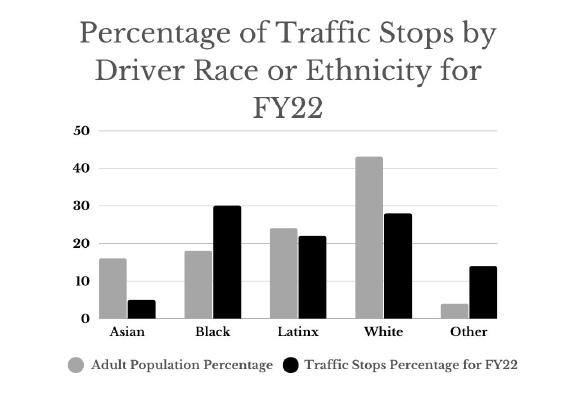

The Safety and Traffic Equity in Policing (STEP) Act proposed by Jawando makes an effort to minimize the disproportional enforcement of traffic stops on people of color. “Every resident deserves to be safe. Low-level traffic stops do not produce additional safety and have a disparate and detrimental impact on community morale and trust of law enforcement,” Jawando writes in a press release from February 28. “Montgomery County is a leader on many innovative programs from police accountability to community-informed police training, and the Act is a step forward for our County in addressing racial disparities and resource capacity challenges within our police force.”
If enacted, the bill would prevent law enforcement officers from conducting traffic stops based on violations of traffic laws involving tinted windows, defective headlamps and tail lights, illuminated license plates, and minor obstructions to windshields, among other violations indicated in Title 22 of the Transportation Article in the Annotated Code of Maryland. Additionally, the legislation would limit the ability of officers to conduct searches of vehicles.
Jawando believes the STEP Act will combat two problems the county faces: traffic safety and equity. With the concerning numbers
of traffic fatalities, Jawando argues that law enforcement officers must prioritize policing dangerous driving rather than minor violations.
“People are dying on our roadways [at] almost double the rate of homicides,” Jawando says in an interview with Silver Chips. “Most of those [deaths] are from drunk driving, impaired driving, speeding, running red lights, not obeying traffic signals, so there’s a prioritization that needs to happen.”
Jawando also emphasizes the bill’s goal to address racial disparities within the county. “The STEP Act addresses the problem of disproportionality in the contact that police are having with members of the black community in particular,” he says.
County Councilmember Kristin Mink co-sponsored the bill for similar reasons. “I agree that we need to be more strategic with our use of police time,” Mink says in an interview with Silver Chips. “I also think that it’s important to address the racial disparities that we’re seeing and this bill does both of those things.”
Mink also mentions the police shortage to emphasize the need for prioritization in traffic enforcement. “We are understaffed in
publicly supports the bill. “The STEP act would be a step in the right direction for people who are severely and negatively affected by minor traffic stops,” member Petros Bain writes in a text message to Silver Chips. “The right direction would be limiting the interaction between police and people who are stopped for minor traffic stops.”
Bain has had personal negative experiences with traffic stops in Montgomery County which have influenced his support for the bill. In one instance Bain alleges he was pulled over late at night while riding home with friends, despite typical behavior he feels shouldn’t have warranted the stop. “There was nothing going on in the car. There was no drinking. [The driver] wasn’t swerving. Nothing extremely noticeable,” he says. “And then we were stopped and harassed. We were asked about weed. I can tell you positively there was no weed in the car.”
The Montgomery County Police Department (MCPD), however, does not support the proposed bill, as they believe limiting traffic enforcement would create a barrier for police to keep the county safe. “I think the STEP Act, while
statements about several traffic stops that resulted in the discovery of high volumes of illicit drugs or weapons. They argue that the stops are necessary in preventing harmful substances from being released to the public and maintaining safety. The statements were posted on the Montgomery County Department of Police website in addition to being shared on social media and news platforms along with photos of the obtained contraband.
In March, MCPD published a release announcing an arrest resulting from a traffic stop which uncovered over 2,000 fentanyl pills. Picerno emphasizes the impact of keeping large amounts of harmful drugs away from the public. “The DEA says 60% of every fentanyl pill has enough fentanyl to be potentially fatal in overdose. That’s
aware of a couple [of] things: what the risks are [and] to make the community informed that we’re doing something about it,” Picerno says.
However, Jawando believes such incidents do not serve as arguments against the
pretty much every county department, including police,” Mink says. “So it’s important for us to be strategic about how we’re deploying the officers that we do have.”
Young People for Progress (YPP), a local organization that advocates for progressive policies,

well-intentioned, puts further burden on law enforcement to not be able to make those traffic stops that are going to save lives,” Special Investigations Division Captain Nick Picerno says.
Following the introduction of the STEP Act, MCPD released
potentially 1100 overdoses being prevented,” he says. “There is zero doubt in my mind that there were lives saved by that traffic stop.”
Picerno says that MCPD is obligated to share these releases to ensure safety. “We have an obligation to make sure the community is
STEP Act. Jawando explains that traffic stops so rarely result in these findings, especially from minor violations that would be affected by the bill. “[It’s] the idea that because someone has a taillight out, you’re gonna find a gun on the street. It doesn’t even make common sense, and it’s a disingenuous argument,” he says.
At a meeting with the Montgomery County Police Accountability Board, Jawando stated that of 40,000 stops, only 200 resulted in guns or drugs being recovered.
Picerno argues that police presence through traffic stops improves road behavior, keeping drivers and pedestrians alike safe. “Having a police officer seen [on the road] improves community safety, and I don’t think you can necessarily put a cost on that,” he says.
The STEP Act will be debated by the County Council’s Public Safety Committee in July. Jawando and Mink are the only council members publicly supporting the bill, but Jawando says he will try to collaborate with others to get it passed. “I’m always open to working with folks trying to compromise,” he says. “I think the biggest thing to do is making sure the community is tapping in. We had a very effective public hearing.”
Reflecting on the public hearing, Jawando highlights the importance of solving the problems that community members shared. “One of the things you’ve heard at the public hearing is that these are not uncommon occurrences, particularly for Black and brown residents,” Jawando says. “It’s not an effective use of police time. It also has a really negative and corrosive effect on the individual.”

“Once you get into your sciences… if you don’t have that knowledge or you haven’t worked within the medical field or the science field, or if you’re not an [expert] in math, you’re not going to have that broad range of vocabulary,” Cole says. “If you want somebody to come into the educational system that knows the subjects and the language and the vocabulary, you’re gonna have to hire somebody seasoned, and you’re gonna have to pay them higher… because they’re not being [given] an equitable pay for their experience and their knowledge.”
teach them to read, we’re teaching them their lessons… They have to have a relationship with the interpreter.
teach them to read, we’re teaching them their lessons… They have to have a relationship with the interpreter,” Cole says. “A lot of times [students] don’t have a parent that [they can] communicate with, unless they come from a deaf family, or parents that are interpreters. It’s a crucial role for an interpreter to be able to be [their] mentor and someone they can trust to be able to interact with others.”
According to the Pezzarossis, not being provided with an interpreter for school events damages their son’s education and their access to equal educational opportunities, “Our son’s education is harmed when MCPS fails to provide full access to information and communication made available to hearing parents. Limiting our ability to fully participate effectively cuts our son’s access to support enjoyed by his peers,” they write.
RANA COLE
Cole explains that interpreters play an important role in the education of deaf and hard of hearing (HOH) children, as interpreters can understand and converse with students, establishing essential relationships. “[Interpreters] are tutors, mentors, educators. We
The situation would have been much worse if we did not have access to that privilege of fluency with English and bureaucracy.
not have access to that privilege of fluency with English and bureaucracy.”
Cole believes that all students must be provided with the appropriate support in order to have equal access to their academic opportunities and education. “I hope
that people come to realize that all students deserve an equitable education,” she says. “They deserve to have the staff there that can support them and let them have access to the education that everyone has access to. I hope they come to the decision that it is something that
Other MCPS students have found that they are not given necessary educational accommodations by their schools, or that their accommodations are ignored by teachers. Blair junior Martina says that she has experienced multiple instances where the school failed to provide legally mandated accommodations, including extra time on tests, the opportunity to test on a computer, and pre-written notes provided to her in each class. She says that she has experienced a lack of transparency in MCPS as well as a large amount of bureaucracy. During her sophomore year, Martina was barred from using a computer on the short answer section of an AP exam. The school did not
have Martina’s full accommodations on record, and when the issue came up halfway through her test, administration made the executive decision that she would not be allowed to use a computer, although the accommodation was promised to her previously. “My mom contacted College Board [who told] us that we needed to have the school file an incident report,” she says. “[Administration claimed] they filed an incident report but… when we asked them to show us a copy, they were like ‘we don’t have it on record.’” Martina believes that being forced to write her test by hand may have negatively impacted her test score.
Martina also believes that the situation would have been much more difficult if her family was not equipped to deal with the school system. “My mom has a lot of time and has a lot of experience advocating for me and working with the school, so we were able to resolve all of these issues, but it took hours, and pretty significant maneuvering,” she says. “The situation would have been much worse if we did
 By Zoë Kaiser Editor-in-Chief
By Zoë Kaiser Editor-in-Chief
Stormy skies batter a group of tents along Route 29, shielding County Council members, County executive Marc Elrich, and business owners as they take part in the Burtonsville Community Plaza’s groundbreaking ceremony. At the ceremony, developer and Blair Alumnus, Jason Miskiri announced the construction of a new fitness center that will be located in the plaza.
Keep moving, regardless of age.
We want to give everyone the opportunity to reach their potential.
Historically, Burtonsville has served as a hub of community and business. However, over the course of the past decade business has dwindled, with COVID-19 worsening the situation. Now, efforts to re-establish Burtonsville as a center have re-emerged. A handful of Burtonsville residents made time to attend the ceremony, bringing with them their passion for the development of the town.
According to Miskiri, the ceremony offered a chance for locals to celebrate the plaza’s expansion and learn of developers’ goals for the area. “The importance [of the ceremony] is to give awareness to everyone that we have something coming that is going to be a part of their community,” Miskiri says. “It’s a big piece of land that hasn’t been used for over a decade. We’re
trying to bring life back to Burtonsville that was lost for so many years.
I think everyone in the area is looking forward to it.”
Miskiri’s fitness center is intended to bring opportunities for health and wellness that are accessible to all ages, body types, and abilities. Miskiri describes his vision for the center as an inclusive environment.
“We plan on building a constant culture where everyone feels welcome,” he says.
As a long time athlete and a former professional basketball player with the Charlotte Hornets along with other professional teams, Miskiri’s passion for fitness is personal. Miskiri also represents his area as an alumni from Montgomery Blair HS, and is a restaurant owner in Silver Spring. He hopes to uplift customers at his gym. “I wanted to do something to give back to the community and help to inspire [youth] to want to stay fit in gener-
al,” Miskiri says. In addition to offering fitness classes, the center will offer financial literacy programs for young people in the area. AsMiskiri explains, financial literacy often proves to be crucial for athletes.
“This understanding [of] how to handle your money, and the importance of saving and investing; a lot of athletes don’t understand that,”
Miskiri says. “A lot of athletes are broke after they’re finished playing because they don’t understand where to put their money.”
Blair Junior Ian Sellars’ journey in the gym began in Blair’s weight training class freshman year. Sellar has a passion for fitness and comments on the value of financial literacy for students. “I absolutely think financial literacy is a resource that’s useful for people. I think that it’s one of the best things that [students] can learn,” he explains.
Sellar also echoes Miskiri’s sentiments regarding accessibility in the gym. “If someone has a disability,
the gym staff should absolutely try their best to be accommodating, and work with the person to help them achieve their fitness goals,” he says.
Miskiri’s own experience feeling undereducated on financial literacy when he was younger, drove him to include this program in his center. “I didn’t learn about [financial literacy] until much later [in life]. [I am] teaching the kids and also the parents these things because it gives the kids an opportunity to prepare them as they grow,” Miskiri explains.
The surrounding area will ben-
efit from accessible gyms located in all parts of Montgomery County. As people spend more time in Burtonsville and the new plaza, there will always be a reminder of health,wellness, and the importance of community nearby. Miskiri emphasizes the benefits of remaining healthy through fitness.
“Keep moving, regardless of age. We want to give everyone the opportunity to reach their potential. Mind, body and soul, if you feel good in those areas then you’ll have a long life,” Miskiri says.
[Interpreters] are tutors, mentors, educators. We
We’re trying to bring life back to Burtonsville that was lost for so many years. I think everyone in the area is looking forward to it.
In the heart of the bustling Friendship Heights D.C. Metro Station, amidst the rush of commuters, station manager Adiel Brown watches as several passengers jump over the turnstiles to avoid paying the Metro fare.
According to Adiel Brown, while evading the Metro fare has been a common occurrence at the station for years, it has become more prevalent after the pandemic.
“It seems like [jumping the turnstiles has] gotten more aggressive since we’ve come back to full service,” she explains. In fact, the fare evasion rate doubled from 17 percent in 2020 to 34 percent in 2022.

One frequent jumper, Blair junior Alden Newsome, explains that he evades the fare in order to save money. “I have saved myself easily over $100 this year by jumping every turnstile. It’s also very easy, considering there’s no enforcement of it, so I don’t feel any worry,” Newsome says.
Newsome is not the only passenger to skip the Metro fare. In 2022 alone, the Washington D.C. Metro estimates that at minimum, more than $40 million in revenue was lost due to the Metrorail and Metrobus fare evasion, approximately 15.8 percent of their expected fare revenue. To combat this issue, the Metro Administration is planning to install taller fare gates throughout stations in the Washington D.C. Metro area.
Currently, the Metro imposes a $100 fine as punishment for jump-
At the height of the COVID-19 pandemic, while many were trapped at home, Blair junior Jo Grospierre found the time and inspiration to write her novel. “Hymn of The Night” is about a Hungarian teenage girl discovering her life’s purpose. Grospierre began the novel in the midst of quarantine as a freshman and finished it late in her sophomore year. She used her time in quarantine to write her novel as a means to unwind. “I was just doing it for fun. It was a way for me to relax, especially [in my] freshman year because it was [during] COVID,” Grospierre says.
On May 8, several Montgomery County youth safety advocates from the Vision Zero Youth Ambassador Program took over the Montgomery County Department of Transportation (MCDOT)’s social media platforms for 24 hours. Among these students was Blair freshman, Skyler Xue. “I participated in the Vision Zero Youth Ambassador program and was in the social media group [where] I was lead ambassador,” Xue says. “I saw multiple traffic safety measures taken around my community and I wanted to know [more about] how to help.” Vision Zero is a program designed to
ing the turnstile. However, this seems to be a low threat, as the station managers have no authority to stop or fine individuals. “We’re not law enforcement, and we don’t have the authority to stop them in the city of DC. If the transit offices are here, they have the authority to distribute disciplinary actions,” Adiel Brown explains. Unfortunately, due to the small size of the transit officer force, many fare-jumpers face no consequences. “We have a very slim staff, so the force is not big. They can’t be everywhere all the time,” Adiel Brown says.
The Metro Administration also specifies on their website that the fine is not always implemented.
“If you don’t pay your fare, Metro Transit Police could fine you,” the Washington D.C. Metro Area Transit Authority website reads. “You’re only fined if you’re caught. That’s why it’s ‘could,’” Adiel Brown clarifies.
Blair students confirm that they have never been stopped by Metro employees when jumping the turnstiles. “I was never fined. Security guards… don’t care. I was probably yelled at by one of them, but I think I just ignored them and kept going,” Blair junior Andrew Morales says.
Adiel Brown expresses that improved fare gates are the solution to stopping turnstile-hopping because their increased height is more challenging for passengers to easily jump over. The taller turnstiles have already been implemented at Fort Totten station, serving as prototypes before they are implemented throughout the Metro system. According to Metrorail conductor Yoseph Feyissa, the Metro administration is investing a large sum to execute the taller turnstiles. “They are going to spend up to $45 million to do [this] throughout all Metro stations,” he explains.
The Metro has also sought to prevent fare evasion by placing plastic arches on the metal portion of the turnstiles, so that passengers
By Dyan Nguyen Design/Sports EditorGrospierre spent her free time learning about Hungarian history after discovering that her family’s hometown in Poland was primarily a Hungarian settlement. Her fascination with Hungarian history was the original inspiration behind the novel. The plot, follows a clan leader’s daughter, Meraki Vargea, who is forced to decide the fate of her future. She must choose to be a savior of her clan or an outcast; a burdensome decision that will change the trajectory of her life.
The writing and publishing process can be intimidating for young writers like Grospierre, but she testifies that self-publishing on Amazon made the process less fright-

encourage traffic safety and eliminate traffic fatalities and severe injuries. The program was first used in Sweden in the 1990s and created a policy that required the reduction of fatalities and serious injuries by 2020. The program was proved to be highly successful throughout Europe, in countries such as New Zealand, The Netherlands, and others. Vision Zero is now being implemented in several U.S. cities, including Portland, Chicago, New York City, Washington D.C., and more.
The social media takeover consisted of posts on MCDOT’s Twitter, Instagram and Facebook. “We prepared the posts and on May 8, the Department of Transportation
have a harder time holding on in order to jump the turnstiles.
Feyissa explains that the new fare gates have already made an improvement when it comes to fare evasion. “Just by [implementing the new fare gates], [the] Metro [managed to control] 60 percent of fare evasion because they just [extend the gates] very high so they’re hard to jump,” he explains.
Blair junior Savannah Brown believes that these new gates would prevent her from skipping the fare.
“I’m just scared honestly and I might also end up falling over. So I kind of prefer to save myself from embarrassment… I would definitely avoid [jumping] more if [there were] higher turnstiles,” Savannah Brown says.
However, the new turnstiles are not enough to deter all students. “I jumped [the new turnstiles] too. I used my arms to really boost myself over those clear gates and it was a little more difficult but honestly, that just felt more rewarding after I managed to do it,” Newsome says.
Newsome adds that charging a fare on the Metro is hurting more vulnerable low-income populations
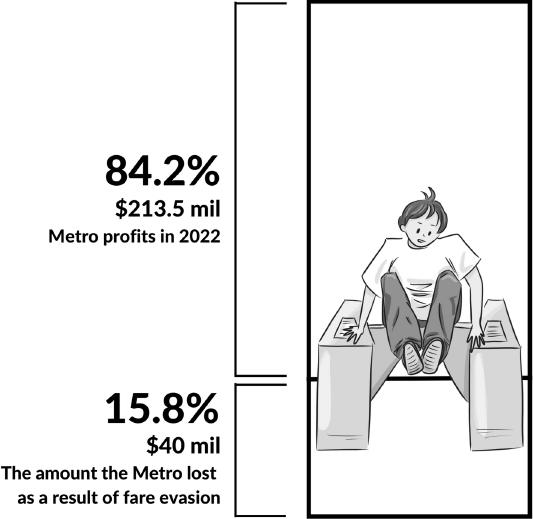
and discouraging environmentally friendly public transportation.
“The people who are already in need of the Metro [are] people who don’t have access to private transport, which are presumably low income. It’s hurting them more to charge fares,” Newsome says.
“It’s de-incentivizing the most environmentally sound form of transport. There’s so many downsides to charging any fare at all.”
To address these issues, Morales proposes an alternative for low-income individuals to be able to take the Metro without paying.
“I think that you should be able to sign up for a free option if you are not financially able because it’s the cheapest option if you don’t have a car,” he explains.
Rather than higher turnstiles, Savannah Brown feels that the real solution to stopping fare evasion is to make the metro more accessible to all. “The problem isn’t the turnstile itself,” she says. “The actual solution would be to focus on providing cheaper, more accessible transportation. That would be the biggest deterrent for jumping turnstiles.”
ening. “I just didn’t really like the traditional publishing industry, just because it was scary [being a] highschool [student] so I decided not to do it,” Grospierre says.
However, Grospierre faced financial challenges being a self-published author, as she had to fund the novel herself. “You can publish for free through Amazon, but you have to pay for [the whole publishing process] on your own,” she says. As a young writer, Grospierre had to find ways to save money.
“I have a friend who’s an English teacher who helped me edit so that was nice, and I’m an artist as well, so I did my own cover,” she says.
Becoming an author is a difficult
handed over the social media account to us and we posted [them],” Xue says. The instagram posts consisted of messages including, “We believe in creating safe infrastructure and promoting safe driver behavior.” Another post encouraged viewers to use public transportation to reduce the impacts of climate change.
The difficulty of preparing and coordinating a team to work together was a challenge for Xue as he took on the role of lead ambassador. “Some members of my group couldn’t agree on a time for when we should all meet together and check in on each other,” Xue says.
Xue found that valuing productivity and time management con-
task on its own, but being a young author is even more demanding. Grospierre learned a number of significant and unique lessons while writing her character’s story, including what mistakes to avoid in her day to day life. “I learned a lot through my character’s experiences because she would do dumb things and then [I] have to learn from them and it’s kind of like saving me the trouble of having to go through those dumb things too,” Grospierre says.
The novel “Hymn of the Night” is now on pre-order; it will be available on Aug. 18 and can be purchased on Amazon.
tributed to his success as an ambassador. “I’m a very productive type of person so I can finish my tasks pretty quickly and I like to manage my time [well],” Xue says.
While Xue does not have specific career aspirations, he believes that being a part of the program was beneficial and gave him ideas for his future professional path. “I’m not quite sure yet on what my future career should be. I don’t know if I [want to do] something similar or different, but I’m definitely interested in [social media management or transportation], so I

do something similar in the
he says.
Why is it important to have journalists from the LGBTQ communi- ty reporting on these issues, and how does journalistic objectivity and conflict of in- terest play into that for you?




How has it been making the transition and taking over for Caitlynn Peetz?
I cannot tell you the amount of times that I’ve heard ‘big shoes to fill,’ when I talk to people. She was definitely very much beloved here in Montgomery County, so it definitely put a lot of responsibility on me taking on this role, and I took it very seriously from the beginning. But it’s been really special to be able to carve out my own beat and my own sources and reputation here in the county.
Going into the field, as a member of the
ty. Did you notice any difficultiesbeinga journalist and kind of having that identity?
I think it can be a blessing and a curse. Being non binary is a uniquely visible way of being queer. There’s no way to hide that you’re queer if your pronouns are they/them, and you’re out about it. It definitely has helped me forge some unique connections with people who are more comfortable speaking to me, because they know [that] I get it. But it can also be a little bit trickier. There’s a huge push in journalism to make sure that your coverage is balanced and objective and that you include the other perspective. So it can be really tricky to include the other perspective when they might not be willing to talk with you because of your identity. That’s always something I’m a little bit wary of going into interviews with people that I know don’t believe in LGBTQ identities or respect them.
As of recent, you’ve beenreportingon pride and a lot of relat- ed issues within MCPS specifically. Could you speak a little bit more about that?
It’s actually one of my favorite things to cover, obviously, it’s very close to my heart, something I’m very passionate about. The lawsuit has been really interesting to follow, and as somebody with a strong background in the legal [and] court system, it’s been uniquely interesting for me to see how that’s been developing. But I’m very concerned [about] what this could mean for Montgomery County. I have only been here a short time, but I haven’t seen any amount of protest or uproar as heavy as I’ve seen with this lawsuit.
Well, I think whenever you have a marginalized community, there’s going to be a sense of distrust with the media. Historically, that’s always been the case, whether it’s LGBTQ, black community, immigrants, they’re generally not super trusting of the media and have every right to feel that way. But I think one of the best ways that we can reforge those connections and rebuild that trust is to have people in the media that are like them, so they see themselves reflected in the reporting that they’re relying on for information—and I have personally experienced that as a reporter who is queer. People within the LGBTQ community are much more likely to talk to me honestly, and be quoted in print. It’s kind of a dangerous thing for a marginalized community member to be putting themselves out there in the press, and you’re really asking a lot of them sometimes, especially students. Whenever I have a student who’s willing to go on the record, I’m just so grateful, because I know that they could be putting a target on their back at school.
For the future of your career, do you plan to continue in journal- ism? Is there anything that you’d specifically be interested in covering in Montgomery County?
I love to keep an open mind. I’m still very young in my career, so I’m just kind of trying to figure out what fits and what works well for me. I really do genuinely enjoy journalism, even more than I thought I would going into it. But it’s been really cool to be able to
connect with people. I can’t think of any other job where you get paid to talk to random people and be like, ‘hey, tell me what you know about this.’ So I really enjoy the community building aspect of the job, and I could see myself doing that for the foreseeable future… I think that there’s a huge need for more gender affirming care here in Montgomery County, that was something I kind of stumbled on when I was covering this lawsuit. So I think that’s something that I personally would like to look more into covering.
Opinions stated by Espey are their own and hold no ties to Moco360 as an organization.
Without new editions of Silver Chips for July and August, you might be feeling lost and confused on how to spend your time without a paper in hand this summer, but do not fret! Let Silver Chips enhance your summer vacation with our Summer Bucket List of 100 activities.
1. Go camping with friends
2. Do an acrobatic yoga class in DC
3. Do a yoga class with mountain goats
4. Pretend to go on a super fancy, exotic vacation, and stage it all on Instagram
5. Go on a picnic at Washington Mall
6. Take your friends on a safari of your life; drive them to your old kindergarten and past schools all the way up to high school. You could also go on this trip by yourself and reflect.
7. Research an ancient religion
8. Watch the entirety of a forgotten movie trilogy
9. Go on a hike following D.C.’s canal system
10. Volunteer for a cause you believe in
11. Go to medieval times and watch a jousting match
12. Take a master course on something you have always wanted to learn
13. Start writing poems—about anything, anyone, anywhere
14. Start a video diary to document your summer
15. If you go on a vacation to a faraway place, meet locals and ask them for their daily routine, then follow it.
16. Investigate the accuracy of conspiracy theories and attempt to uncover a hidden international secret society. If no secret society is found, make your own!
17. Show your parent that they are loved.
18. Write letters about everything you wish you could say to people, address it to them, and keep them in a box.
19. Coach a sport you love at a local rec center 20. Find a pen - pal. The apps “Slow - ly” and “Bottled” let you use social media to do this, however, the tradi- tional buy an ad in a distant land’s news- paper still works, and it supports newspapers.
21. Try a new hairstyle 22. Clean out your closet!
Donate old clothes to the thrift store and buy new ones (try to shop sec- ond hand).
23. Host a cooking
competition with your family, friends, neighbors, etc.
24. Start a side hustle. Some of the easiest side hustles include pet sitting or dog walking, making and selling your own crafts or babysitting.
25. Start meditating
26. Find “your spot:” somewhere secluded that you love, where you can just sit, think, and be you
27. Build a mini diorama of your room
28. Go to art museums such as Zenith Gallery, Portrait Gallery, UMD Art Gallery, Glenstone, etc.
29. Have a water balloon fight
30. Go on a beach trip with friends or family
40. Give your pet their dream day
41. Go to a drive in movie theater
42. Get off at every stop on the red line
43. Have a diving competition with friends
44. Compete in a Pickleball tournament
45. Make your own pickles
46. Go to the D.C. spy museum
47. Go to every Smithsonian museum
48. Try to find your way onto a yacht or other boat
49. Redecorate your room
50. Make a piece of clothing for yourself from scratch: design it and sew it.
51. Go to a flea market and bargain
64. Camp next to your house
65. Run a 5k
66. Go to a roller skating rink
67. Have a thrift store fashion show. Go to a thrift store with your friends. Have everyone buy outfits and then present them on a catwalk.
68. Go fishing
69. Invite all your neighbors over for a potluck
70. Rent a bounce house
71. Learn to break-dance
72. Develop your own signature dance routine
73. Read a book
74. Volunteer to take a rescue animal on a walk
75. Learn a new language
76. Try foods from each continent
77. Make a cookbook for your families recipes
78. Do a spa day for someone special in your life (or yourself)
79. Visit the historical landmarks near you
80. Make a collage
81. Try casting a spell (see “Modern Witches” from Silver Chips March edition)
82. Pull an all nighter
83. Set up a slip and slide
84. Learn an instrument
85. Go to Adventure Park, a ropes and zipline course in Sandy Springs
86. Host a dinner party
87. Start a scrapbook
88. Go stargazing
89. Do a phone or technology detox for a week
90. Try to prevent the next pandemic from spreading
91. Oh no! You failed step 90, now build your zombie apocalypse survival plan
31. Try a new sport
32. Play chess with strangers in a park; there are often people playing in Dupont Circle.
33. Attend or volunteer at a retirement home’s bingo night
34. Interview a local celebrity
35. Try water polo or synchronized swimming

36. Have a Nerf Gun battle with friends in your neighborhood
37. Make a pillow fort
38. Have a traditional sleepover: put on nail polish, curl your hair, gossip, wear matching pajamas, have a pillow fight, love your friends fully.
39. Sit on a porch, drink iced tea
Platinum
Gold
Silver

Kate Stewart - Susan Heavey
Bronze
52. Trade a pa- perclip or other small object all the way to something valuable
53. Online shop on Facebook marketplace
54. Start playing fantasy sports
55. Go to a fair or carnival and ride every ride

56. Get into crossword puzzles
57. Be a guest columnist for a newspaper
58. Get a piercing
59. Write short stories
60. Go Indoor skydiving
61. Attend an outdoor concert
62. Pick an artist you’ve never heard of and listen to their entire discography 63. Go white water rafting
92. Go on college visits. At these college visits, find one niche thing that you can do that is more fun than listening to a guide say, “Yes, we have study abroad. No, we don’t take AP credits.” For example, collect the student newspaper, collect posters from the bulletin boards, buy a book from each of the campus libraries, collect keychains, etc.
93. Make a charcuterie board
94. Go to a cat cafe
95. Ride scooters around D.C.
96. Visit the Library of Congress
97. Bake and decorate a cake
98. Go to the Kenilworth Aquatic Gardens and see the waterlilies
99. Make your own list of 100 things to do over the 2023-2024 school year
100. Read the Silver Chips newspaper front to back and write a letter to the editor
If you would like to support the paper, go to tinyurl.com/subtochips to subscribe to Silver Chips, be featured on the paper, and receive merchandise.
Chris Moriarity - Diane Kelleher - Jennie Guilfoyle and Mark Swartz -
Amy Schwenkmeyer and Rolf Reichle - Chenmuren Zhang - Emil Parker - Geoffrey Egnal - Hester Baer and Ryan Long - Joseph P Kowal - Paul B. Ellis - Katherine and Dan Hinckley - Katy and Bart Friedman
Marcela and Philip Bender - Mark Amaral - Mitch Warren & Joanna Slaney - Peter Colavito - Stefanie Weiss Stuart Guterman
Amy Cooke - Anne Pfitzer - Alison MacDonald - Cathy Feingold - Cathy Henderson - Claudia DeaneCorinne Nash Sauri - Elizabeth Keyes - Gary Anderson - Gary MacDonald - Hans Riemer - Jason & Jamie Fasteau
Jorge Munoz - Joseph Fanning - Katherine & Dan Hinckley - Kathy Cole - Kurt and Dot Kasik - Lorig
Charkoudian - Maria Vélez - Mckinley Jovanovic - Mica Bevington - Michael Newman - Nicholas Jovanovic - Nina Schwartz - Pamela Winston - Reemberto Rodriguez - Rex Robison - Ron and Connie Hanson - Sarah HansonTami Spire - The Holmquist Family - Marina Deane-Gonzalez
The beloved Silver Spring establishment, Tastee Diner, abruptly closed on March 22. The diner originally opened its Silver Spring location in 1946, and remained a favorite of many up until its final day. The Montgomery County Council even deemed the spot a historic landmark in 1994.
When the diner first opened, it was located on the corner of Wayne Avenue and Georgia Avenue, but it was forced to relocate in 2000 in order to make room for the Discovery Channel headquarters. The iconic railroad-like dining car was loaded onto a truck and moved to its current location, where it has
remained until the announcement of its closure earlier this year.
Many Silver Spring citizens were shocked about the closure, as the diner had given no previous warning. The diner’s sudden closure was announced through a note taped to the establishment’s front door that read, “Thank you for the opportunity of letting us serve you for so many years.” The closure came as a surprise to everyone, including workers, who were given just as little notice about the closure as the general public and were distraught over the news.
The reason for the closure was not immediately released, but the diner’s owner, Genes Wilkes, eventually said that he sold the diner due to “personal medical reasons.” Soon after, it was revealed

that the iconic location had been sold to Roadside Development, a real estate firm. Roadside Development obtained the property in order to redevelop it into a mixed-use residential area.
However, the sale of Tastee Diner to Roadside Development was a point of contention in the Silver Spring area. Many Silver Spring residents were angry that the landmark diner was being turned into a residential area and feared that the sale was part of gentrification occurring in the area.
Despite the loss of the beloved Silver Spring location, Tastee Diner has not disappeared entirely from Maryland. Two more Tastee locations—in Bethesda and Laurel—remain open and ready to serve.

“What students think about Tastee diner’s closing”
“[Tastee Diner] was a really nice place. You can just sit there for hours. If it’s cold outside and rainy ... there’s nowhere else that you can go and get a coffee similar to [Tastee Diner’s].”
NOAH LEBLANC junior“Tastee Diner’s significance as a historical landmark [in Silver Spring] should have warranted more preservation efforts from the county. Their negligence shows the state of Silver Spring and how it’s being gentrified and run over by all these finance people.”
By Sophie Yohannan Culture Editor and ColumnistWelcome to Best of the Best!

To kick it off for the first edition, I sampled french fries from eight different chains to determine which deserves the title of Best Fries.

The first frystablishment on the chopping block is Santucci’s Deli in Four Corners. Naturally, I had to go for Santucci’s Old Bay fries, which come in a paper cup overflowing into an oily brown paper bag—that’s how you know they’re going to be good. Santucci’s largely fits my texture preference for fries: crispy on the outside while soft on the inside. The Old Bay is an endearingly Maryland touch, and the seasoning and breading don’t com
ery other measure.
At BurgerFi, I was shocked by the sheer amount of fries in the bag—enough to make Five Guys look like a light snack. BurgerFi has an impressive—if not overwhelming—selection of fry styles to choose from. I went for Parmesan & Herb, which formed a unique flavor profile. The seasoning, potatoes, and excellent BurgerFi Sauce were perceptibly house-made, and this chain evidently strives for quality—which made me want to love these. But… you know what’s coming: not crispy enough!
After this soggy low, I was desperate for a fry with a crisp exterior. And lo and behold, I found it—in the unlikeliest of places. Dog Haus’ claim to fame is meat, particularly “dogs” and “wieners.” At this restaurant, fries are simply a side to go with your burger. But they are clearly not an afterthought. These standard-cut fries were simple, yet lessly fried, satisfyingly crunchy, and equipped with a tasty, classic flavor that needs no sauce to save knew from the first bite that I had found
ly delightful, but functional, as they make a flawless shape for dipping in Chick-fil-A’s trademark sauce. I imagine the perfect fry to be a tad crispier, but this was a solid contender.
Everyone seems to rave about McDonalds fries, but last time I had them, I hated them. Nevertheless, I was excited to re-evaluate them and potentially proclaim my hatred for them again. I took my first bite and found that these fries weren’t quite as dreadful as I’d remembered. But, still, they weren’t that far off. McDonald’s “World Famous Fries,” were oddly thin and short, and lacked flavor. They were crunchy, which I appreciated, but they were missing… adequate potato content. As my friend and honorary co-taster so eloquently articulated, “the outside was the same as the inside.” I would classify this an average, no-frills fry, as McDonald’s achieves satisfactory crispiness while falling short of ev-
But the journey was not over. Next up was The Big Greek ventional restaurant to sample fries from. A friend told me these would be ing,” so I had to give them a shot. I opened the box, and upon seeing ed fries topped with crumbled ized I had prematurely crowned my winner. The fluffy interior enveloped in the perfect crunch, coupled with the sharp tang of the feta, made these fries an absolute ly close to tying with Dog Haus. But considering they offer a real bang for your buck—with more than twice the portion of Dog Haus for the same cost—The Big Greek Cafe officially takes the title of Best Fries.
At the last moment, I realized I had missed a very important candidate in this tournament: Blair’s cafeteria fries. Truthfully, I did not have high expectations here, but it only felt right to try these. Like McDonald’s, they had a slight crunch but were somewhat empty. These fries also lacked any flavor, except a faint hint of staleness. Three bites were all I needed to decide that these would come in last place. I could not even bring myself to finish one fry.
The verdict? The next time you’ve got a hankering for fried potato sticks, head over to The Big Greek Cafe ; their french fries are the best of the best.
For centuries, cultures across the world have told stories of the ever elusive fountain youth. Today, this myth takes a different form: the $67.2 billion anti-aging industry. Companies like L’Oréal, Clinique, and many more, want consumers to believe that drinking from the fountain of youth really is possible.
is skin care, marketed to reduce wrinkles and blur fine lines. However, these claims are exaggerated. For products to penetrate the first layer of skin to produce “anti-aging” effects, they must be fat-soluble and composed of molecules small enough to penetrate the skin barrier. This eliminates three major players from the skin care game: collagen, vitamin C, and hy aluronic acid.
sidered valuable. “The anti-aging products are directed at that whole concept of a woman needing to look young [in order] to be relevant… It’s like you’re… less valued the older you get,” Maples says. The anti-aging industry exploits this insecurity, and makes billions
ti-aging process in their teens to retain their youth.
Even at seventeen years old, Blair Junior Savannah Brown feels pressure to prevent aging. “Even at my age, I feel like we’re concerned about aging… [and] I’m still wanting to prevent aging.”
look younger. “I have a lot of relatives who have [had] some kind of surgery to make themselves look younger… they don’t look like themselves. I feel like they still look
The anti-aging products are directed at that whole concept of a woman needing to look young [in order] to be relevant… It’s like you’re… less valued the older you get.
For the rich and famous, it can be. Through a strain on their wallets and time, some celebrities can meet unattainable physical standards, creating insecurities for the average person, who cannot finance the expense of cosmetic surgeries. The anti-aging industry, therefore, profits off of these toxic standards.
A large faction of the industry
Despite this, dozens of skin care brands promise shining re sults from the use of their prod ucts. Large research institutions such as the National Institutes of Health rarely conduct studies on the integrity of these “anti-aging” assertions, meaning most search claims—the glowing reviews on the bottle—are privately funded by the manufacturer. Some instances of false advertising have been investigated by market watchdogs. In 2014, the Federal Trade Commission found that L’Oreal’s claims about their “Youth Code” skin care line were “misleading” and lacked scientific evidence.
The standards set by these falsi ties have profound impacts, espe cially for women. Andrea Maples, the women’s studies teacher at Blair, explains that even outside of the entertainment industry, women must remain “youthful” to be con
Compiled by Sophie Yohannan and Nora Pierce
Photos by Raffi Charkoudian-Rogers

Pride Family Day
June 17, 11am-2pm
Big Train Pride Night Field
June 17
Pride and Publishing: LGBTQ+
History in Print
June 17, 10am-5pm
Live Tour: Over the Rainbow
June 17, 2 – 4pm
Pride Pawty
June 17, 11am – 2pm
Pride and Unity Quad Roll OUT
June 17, 2 – 5pm
‘We Have Always Been Here’ Film Series
June 18, 24, and 25, 2pm
Trek Washington D.C.
Georgetown Pride Ride
June 25, 9-11am
Rockville Pride
June 24, 1-4pm
Pride in the Plaza Festival

June 25, 12pm
Brown feels that the anti-aging industry twists aging into a negative concept and makes people believe that it can be prevented, even though it is inevitable. “It’s a natural process to age. No matter how much you try to prevent aging, you’re still going to become older… [these] products reinforce the idea of looking younger instead of just promoting [that] you can look your best… at where you are.”
Allison Sweeney, a Poolesville graduate, has also felt pressured to worry about aging. Both Sweeney and Brown have had women close to them undergo expensive and extensive procedures to prevent aging due to standards that cause them to believe that aging correlates to their value as a person. “Women who are older [are] afraid that they won’t have value anymore. They are excised for not being that ideal… So I think that scares young women into trying to do things that they would otherwise not want to.” Sweeney says.
Brown believes that procedures her family members have undergone did not actually make them
Arts and crafts, carousel, and rainbow desserts at Glen Echo Park.
Bethesda Big Train collegiate baseball team holds second annual pride night at Shirley Povich Field.
Display of the Library of Congress’s LGBTQ collections of self-published zines, newspapers, and magazines at the Thomas Jefferson Building.
Queer history walking tour of Washington, D.C. starting at Farragut Square.
Contests and activities for dogs, rainbow dog treats, and a
Beginner-friendly rollerskating meetup dedicated to Juneteenth and Pride Month
Screenings of the works of three LGBTQ artists in a live film series at the National Gallery of Art.
Casual bike cruise to celebrate the LGBTQ+ community, all are welcome.
Live performances, info booths, and arts and crafts at Rockville Town Square.
Drag shows, musical acts, and resources for LGBTQ+ communities at Veterans Plaza.
Women who are older [are] afraid that they won’t have value anymore. They are excised for not being that ideal... So I think that scares young women into trying to do things that they would otherwise not want to.

their age regardless.”
With the common inaccessibility of anti-aging products that truly produce results and the toxic culture surrounding youthful appearances, Sweeney believes that people should embrace aging. “What you look like is the least interesting thing about you…You’re not [defined by] your beauty so just live your life.” Sweeney says.
Scan the QR codes to see the solutions to the Sudoku and Around the World Crossword puzzles. Sudoku Around the World

In each column, each of the digits 1–9 appear once.
In each row, each of the digits 1–9 appear once. In each bolded 3-by-3 box, each of the digits 1–9 appear once.

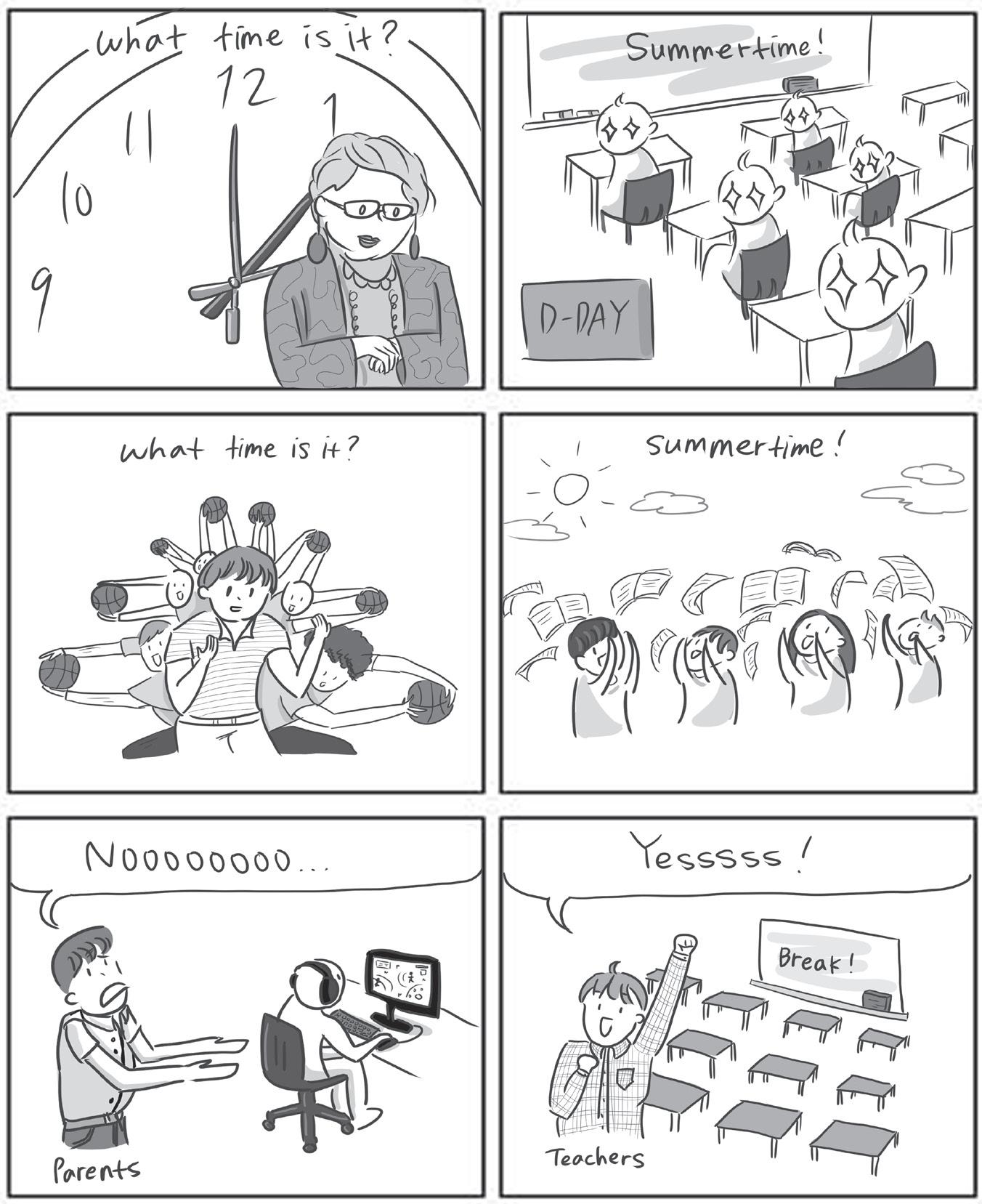
DOWN
1 One of many parts of
2 On-the-go gel fuel brand
3 Aristotle’s distinct realms of oikos and polis
4 Popular Goo Goo Dolls love song
5 Commune regarded as the most beautiful port in southern France
6 Cousins of frogs
7 Time zone two hours behind the DC area
8 Lipton product
9 One who wanders aimlessly with no home
10 Convert sunlight into energy
11 Erases, as on a computer
12 Car battery revival company
15 Hidden catch
21 Received
24 A format of study many college students choose
25 Like a messier, unkempt garden
27 Abbreviation for the home city of the NBA’S Hawks
29 New England’s Red ___
30 Halter, tank, or tee
32 Yosemite and Lake Tahoe’s home
38 Spanish for “to be called”
39 Observe, witness
40 Scrappy the Eagle represents this Denton university
41 Tax-collection service

42 Integers which evenly divide another number
46 Levels of government, as in the AP curriculum
48 “Lose Yourself” artist
49 Sums, again
51 Actress Rae of 2023’s Barbie
53 An offer to a pet
57 Abbreviation for an international monitoring agent
58 How one might get rid of a fly
59 Fez or fedora
61 The meaning of the ampersand
62 A pig’s preferred medium


As the 2023 Women’s World Cup commences this summer, some familiar faces will be missing. Despite advancements in the sport’s popularity and gender equality, players have chosen to sit out of the global tournament to protest inequalities.
The tournament, co-hosted by Australia and New Zealand, will begin on July 20 and culminate in a final match on Aug. 20. The International Federation of Association Football (FIFA) expanded the field of competition this year from 24 to 32 teams—the size of the men’s World Cup.
The United States Women’s National Team (USWNT) will compete this summer as reigning
World Cup champions, having won the two previous tournaments in 2015 and 2019. However, this year, the team returns with new guarantees of equal pay. In December, Congress passed the Equal Pay for Team USA Act, which ensures equal compensation for athletes representing the U.S., regardless of their gender. Additionally, both the men’s and women’s national teams signed new bargaining agreements with the U.S. Soccer Federation in September, that include commercial revenue sharing and equal World Cup prize money.
Some believe that the international success of the USWNT has contributed to these milestones. “I think [the status of women’s soccer has] improved a lot in the past four years,” Blair junior and soccer player Eliza Palmer says. “The fact that the U.S. has been able to win four
World Cups definitely helps [their reputation], because otherwise they would not be getting the recognition.”
The rise in the popularity of women’s soccer was evident in the 2019 Women’s World Cup, when FIFA reported over a billion combined viewers. Nationally, around 14.3 million viewers watched the final match between the U.S. and the Netherlands—22 percent more viewers than the 2018 men’s final.

Blair girls varsity soccer coach Robert Gibb sees firsthand how his players are inspired by the World Cup, as he expects a large number of incoming freshmen at tryouts for the fall soccer season. “I had my smallest number of ninth graders ever try out last year… But normally in a World Cup year, since it’s in the summer, right before [the fall season] I’ll have like 25 girls come out,” Gibb says.
Despite improvements, the Women’s Cup still faces barriers to proper recognition. FIFA threatened a broadcast blackout of the 2023 cup in Europe because the organization could not reach a deal with broadcasters. The broadcasters allegedly offered only $1–10 million for the Women’s World Cup, compared to $100–200 million for the men’s cup. FIFA president Gianni Infantino criticized the bids from Britain, Spain, Italy, Germany and France for not properly investing in the women’s sport. At a May 1 event hosted by the World Trade Organization, Infantino called out public broadcasters’ hypocrisy as they limit funding for women’s sports while criticizing other sports organizations for not paying women and men equally.
More so, female players continue to protest inequality and harm-
ful institutions. Earlier this year, players on Canada’s national team wore shirts with the words
“Enough is Enough” as they stood for the national anthem be - fore their SheBelieves Cup match versus the U.S. The players had planned to boycott the tournament, but were es- sentially forced to play when Canada Soccer compared the protest to an illegal strike.
French national team players
Marie-Antoinette Katoto, Kadidiatou Diani, and captain Wendie Renard have chosen to sit out of this summer’s World Cup in order to preserve their mental health amid a toxic working environment. “Unfortunately, I will not be playing in this World Cup under such conditions,” Renard wrote in a statement. “My face may hide the pain but my heart is suffering... and I don’t want to suffer anymore.” Renard, who plays for the soccer club Olympique Lyonnais, has become one of the most decorated athletes in the sport and was the first woman to make 100 Champions League appearances in April 2022.
For some, star players missing this year’s World Cup has both its advantages and disadvantages. In addition to serving as a powerful protest, it gives young players an
opportunity to show their talent. “I think it could reduce people watching it,” Palmer says. “But also it gives up and coming players the chance to make the roster and play on the teams.” Among the rising stars is the Washington Spirit forward Trinity Rodman, who made her debut with the USWNT in February 2022.
Despite some missing well known players, the 2023 Women’s World Cup will continue to shine a spotlight on the skills and competition of female soccer players and inspire young players. Blair junior and soccer player Goldie Siff recalls her personal experiences as a female athlete. “I would be playing in a soccer game when I was little and it would be really important to me. I would [take] it really seriously and people wouldn’t understand and they would [say] ‘Well it’s just girl’s soccer, why do you
“I had my smallest number of ninth graders ever try out last year… But normally in a World Cup year, since it’s in the summer, right before [the fall season] I’ll have like 25 girls come out,”
care so much?’” she says. “With the World Cup, if people are able to watch women’s sports, they can understand the importance of it to young female athletes.”
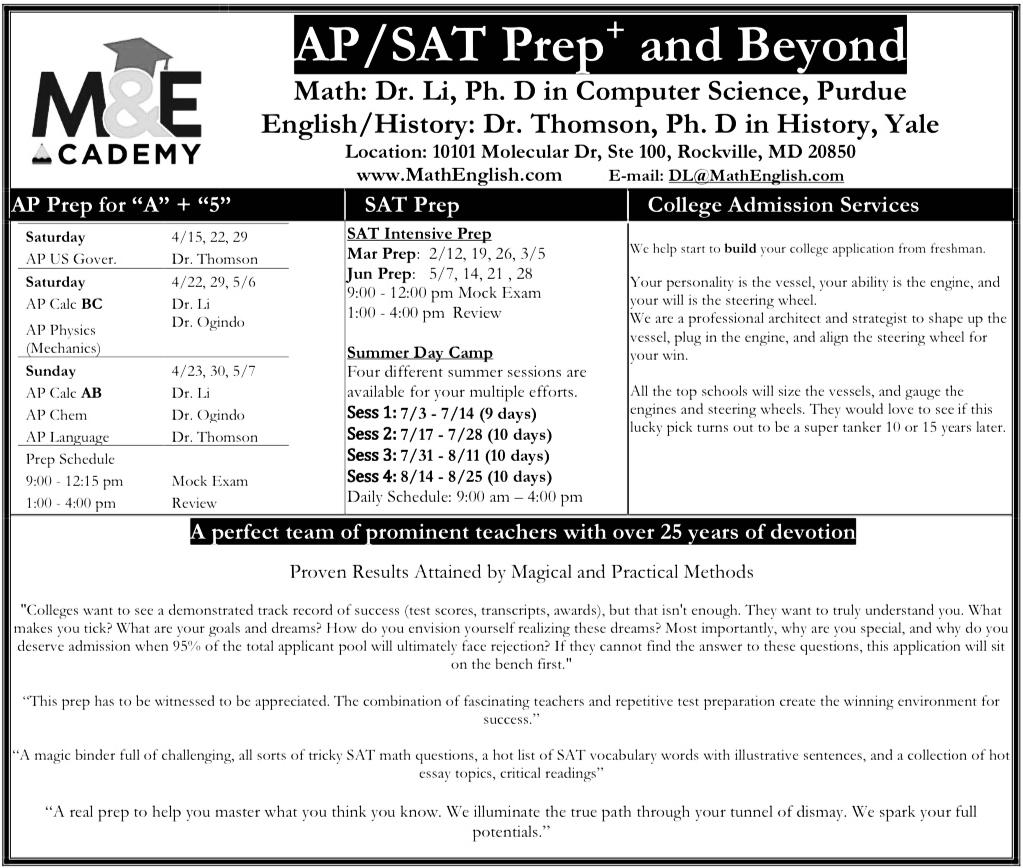

In recent years, Major League Baseball (MLB) has gone through major changes in order to turn baseball into a game that is more appealing for the average viewer. The changes include a pitch timer and a permanent automatic runner in extra innings. All of these changes are meant to increase MLB’s revenue, something that Rob Manfred, commissioner of MLB, hopes the expansion will help with as well. MLB is considering expanding to include 32 teams instead of their typical 30 at some point within Manfred’s tenure as commissioner. The league has not expanded since 1998, and many baseball fans are not happy about the rule changes or the possibility of expansion happening again—myself included—as baseball is a sport rich with history. Changing its fundamental rules and format of play, ruins the continuity of the sport’s beautiful past. However, if Manfred does continue to push to expand MLB, he should at least bring baseball to a city that deserves it. There are a few cities that are presumed to be high on

the list of potential new homes for MLB teams, but here’s a list of cities where MLB teams would surely thrive.
Montreal is not new to the MLB scene. From 1969 to 2004, Montreal was home to the Expos, an MLB team that has since relocated to Washington, D.C. and is now known as the Washington Nationals. With a population of four million people, Montreal is the largest North American city without a baseball franchise. In addition, the city is already home to successful professional teams such as the Montreal Canadiens, a National Hockey League (NHL) team. During the 2022-2023 season, the Montreal Canadiens had an average attendance of 21,078 people, the highest among all NHL cases. The peo - ple of Montreal are sports fanatics, have already had a taste of baseball in their city, and are ready for it to return. There is
also a movement called the Montreal Baseball Project, which focuses on bringing an MLB team back to Montreal.
As most Montreal professional sports teams are named using French words, a fitting name for a potential Montreal-based MLB team would be “Les Castors”. Les castors is French for the beavers, the provincial animal of Montreal.

Charlotte is already home to two professional teams from two of the three most lucrative sports leagues in the country. With the Charlotte Hornets of the National Bas - ketball Association (NBA) and the National Football League’s (NFL) Carolina Panthers, Charlotte is only lacking an MLB team. Charlotte is also home to the Charlotte Knights, a Triple-A Minor League Baseball (MiLB) team that ranks seventh in MiLB attendance for the 2022 season—a statistic that represents Charlotte residents’ enthusiasm for the sport.
Charlotte has also recently gained Charlotte FC, a Major League Soccer (MLS) team. The new MLS team proved to be a success, with the team breaking single-game records for MLS attendance in 2022. Rick Curti, the founder of the Charlotte Bats, a grassroot organization dedicated to bringing baseball back to Charlotte, said in an interview with WCNC Charlotte, “[The city’s response to Charlotte FC] shows people that Charlotte is a great haven for professional sports.”
If Charlotte were to become the home of a new baseball team, it should be called the Charlotte Crowns. Charlotte was originally named after Queen Charlotte, and the crown is already visible on Charlotte FC’s emblem, so the name is an obvious choice.

According to the Portland Diamond Project, a group founded with the goal of bringing baseball back to their city, baseball in Portland would not only benefit MLB but the citizens of the city. “[Baseball in Portland presents the opportunity of] creating employment opportunities, expanding transportation options, adding great public spaces, and building civic pride,” reads the project’s website.
The Portland Diamond Project has also brought in big name investors including football quarterback, Russell Wilson, and singer, Ciara. The project is one of the main draws for adding a team to the city, as they are working to create a partnership with both the citizens of Portland and the MLB in order to make the expansion as efficient as possible. The organization has already secured purchase rights to a site along the Willamette River for a stadium. If the organization is able to secure themselves a baseball team, they would be smart to join the club of sports teams named after birds. Portland’s official bird is a great blue heron, and with a stadium on Willamette River, baseball fans might even get the chance to spot a heron at the game.
In a movement led by ex-MLB player and current board member of Music City Baseball, Dave Stewart, Nashville has been working hard to secure a spot as a future home to an MLB expansion team. According to Stewart, “The growth of [Nashville] creates a great market for Major League Baseball.”

Music City Baseball is yet another organization committed to bringing an MLB franchise into its city. The orga- nization reported having “positive conversa - tions” with Manfred and has already stated that the expansion team would be named the Nashville Stars, in honor of the former Nashville’s semi-pro Negro Major League team. Another big draw for Nashville is the potential St. Louis-Nashville rivalry. Nashville and St. Louis already have a history of rivalry through their NHL teams, the St. Louis Blues and the Nashville Predators. A fun-spirited rivalry between a new Nashville MLB team and the St. Louis Cardinals is likely to draw extra crowds to Nashville stadiums. With crowds and profits being one of MLB’s most important factors in their decisions, a team in Nashville would be beneficial to the sport.
These are just a few of the cities that MLB would be smart to expand to, but many others such as Salt Lake City, Columbus, Orlando, and Sacramento have been mentioned in discussions as well. The choice to expand MLB to 32 teams is still highly controversial, so it is unlikely that MLB fans will be happy with any decision that is made, but if the expansion must happen, the new home cities should be ones that will continue to help baseball succeed in the United States.
Blair junior Siena Gleason breathes in deeply as she steps to the center of the floor. She stands before a line of judges and smiles at them, heart beating faster as her anxiety rises. The other six girls on the team are watching her closely, and they cheer for her as the song for her routine begins to play. She breathes in deep and exhales away her sense of trepidation. She knows her routine by heart, so she lets muscle memory take over for the first few steps, her mind laser-focused on perfectly executing every skill. Gleason glances occasionally at the judges, watching for their reactions, and emerges from her tumbling pass slightly off-kilter, but she corrects her placement, reassuring herself that no one else knows her routine. The rest of the routine goes without a hitch, and she lands with a flourish, raising her arms and smiling at the judges once again as she bows.
Gleason was on Blair’s gymnastics team last year, which is currently composed of 22 girls led by Coach Amanda Pierce. Despite their remarkable winning streak this season, many Blazers are unaware of the team’s existence.
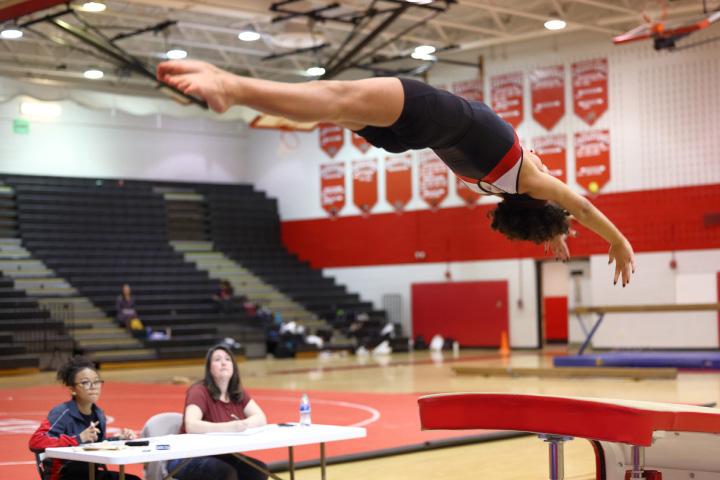


At Blair, the gymnastics team can have at most 25 girls, a limit that Pierce took on to ensure she is able to safely manage all members. Last year, there were only seven girls on the team, a consequence of the pandemic. In recent years, the gymnastics team has rebuilt itself from the pandemic. According to recently-graduated team captain Rachael Young, she is the only one left on the team from pre-pandemic years. “Everyone else that is on the team now has [joined] after COVID,” she explains. Still, Young’s experience throughout her four years has allowed her to better guide the team and help improve the environment.
Team member, and one of next year’s two captains, Jayanna Miskiri explains that the team owes their expansion to Young. “Rachael got a lot of people from our cheer team to join and that’s basically where all of our new people came from,” she
says. The team’s boost from seven to 20 girls has helped improve their competition results drastically. This year, Blair gymnastics placed first—undefeated 2–0—in their division, and they later placed fourth at championships.
Though it feels good to win medals, what the girls love most about the team is the atmosphere of community and friendliness fostered by the members. “Everyone’s so nice and supportive of each other… No one’s judging you because everyone’s messing up on things, and everyone’s growing,” future Co-captain Susae Uzman says.
This sense of openness and
whenever they need help. If you ask her for any of her attention, she’ll give you all her undivided attention,” Miskiri says.
Pierce has been leading Blair’s gymnastics team for 11 years. Before she began coaching at Blair, she coached younger students at summer camps. Pierce’s motivation to coach gymnastics originates from her own interest and experience in the sport. “I grew up doing gymnastics,” she explains. “It was always something that I wanted to keep doing.”
However, being a gymnast is no easy feat. Young describes the sport as not only physically, but mentally taxing. “You take risks. It’s scary; you’re flipping your body in ways that it’s not really supposed to do, but if you just trust what your coach is telling you, you trust your training, and you know how to do… the [prerequisites], you’ll be fine,” she explains.
back,” Young explains.
The courageous spirit is echoed throughout the team. “You have to be willing to try new things… You can’t let the fear of getting hurt take over you learning new skills. The moment you focus on what cougo wrong, you’re already putting a block on you growing and improving as a gymnast,” Uzman explains.
Gymnastics is both individu-
there talking,” she explains.
Even though the team has had a strong track record over the years, many Blair students do not know much about their success. Within MCPS, there are only eight high schools with a gymnastics program, one of which is Blair. On top of that, Montgomery County is the only county in the state of Maryland with a gymnastics program. As a result, many students in the area do not have exposure to gymnastics as a sport. “I just think that as a state, there is not that much word-ofmouth about the high school [gymnastics] program, … so if you’re not in one of [the eight] schools, you probably have never even heard that it exists,” Pierce says.
However, Pierce is confident in her team and their ability to draw in new recruits who may be interested in the sport. “I think that the way that it’s been going the past couple years with the girls passing it along to their friends and other people that might be interested, I think that [the gymnastics team] is continuing to be relevant,” she explains.
Pierce’s confidence is not unfounded. Throughout Young’s
support comes through in Pierce’s coaching style as well. “She’s very supportive. She helps anybody
According to Young, the biggest hurdle to performing well is fear. In order to succeed in the sport, all team members must let go of the anxiety surrounding failure and simply trust in Pierce and their own skills. “You can’t listen to your fear… if you let your fear get in the way, that’s what’s going to hold you
al and team-focused, as gymnasts participate in individual events that contribute to a team win. “There is the opportunity for [the gymnast] to receive an award for [her] own personal accomplishment during [a] competition, but at the same time, the team gets an award,” Pierce says.
Competitions involve four events that girls can participate in: floor, beam, vault, and bars. Each event requires a different skillset, and the gymnasts who participate in the individual events are able to contribute to the final score of the team. The team holds a strong spirit and sense of community surrounding competitions. “We talk about goals and personal achievements that [the girls] want to reach. Then they do a cheer at the beginning to hype each other up. [They also cheer] for each other throughout the competition,” Pierce says.
Uzman explains that the girls carpool to the meets together, which serves as a beneficial bonding experience before the competition. “It’s such a great community building thing personally, because it feels like such a family when we’re riding there because we’re all
captainship, she has been working on efforts to draw more attention and interest to the team. “What I was trying to do this last season that I was here is make [the team] more inclusive and make it more popular,” she says. “So, I started an Instagram account [for the gymnastics team] and [tried to make] it active.”
“You can’t listen to your fear… if you let your fear get in the way, that’s what’s going to hold you back”
Miskiri and Uzman aim to continue Young’s efforts by maintaining an active social media presence, airing announcements on Infoflow, and holding interest meetings. “I’m sure a lot more people [would be] interested [in gymnastics], they just don’t know [about it] ,” Miskiri says.
“Everyone’s so nice and supportive of each other… No one’s judging you because everyone’s messing up on things, and everyone’s growing”
SUSAE UZMANRACHAEL YOUNG Senior captain Rachael Young steps forward on the beam as she completes her routine. UNEVEN BARS Allegra Unger mounts the uneven bars, concentrating on next skill during a meet against Walter Johnson. PHOTOS COURTESY OF TINO PHAM